Pastirčáková Katarína
Plant Pathology and Mycology RG
Researcher

Mgr. Katarína Pastirčáková, PhD.
Slovak Academy of Sciences
Institute of Forest Ecology
Plant Pathology & Mycology Research Group
Akademická 2
949 01 Nitra
Phone: +421 37 6943 358
Email: katarina.pastircakova@ife.sk; uefezima@hotmail.com
Research Interests: Fungal diseases of woody plants, pathogen biology, fungal taxonomy and diversity, Botryosphaeriales, Erysiphales, Rhytismatales.
Education:
- PhD. in Plant Protection; Institute of Experimental Phytopathology and Entomology, SAS, Ivanka pri Dunaji (1999-2002) and Institute of Forest Ecology, SAS, Zvolen (2003)
- Mgr. (MSc.) in Mathematics and Biology Education; Faculty of Natural Sciences, University of Constantine the Philosopher, Nitra (1994-1999)
Academic employment:
- Depertment of Plant Pathology and Mycology (formerly Branch for Woody Plants Biology), Institute of Forest Ecology, SAS, Nitra, Slovakia (researcher – since 2003; Scientific Secretary – since 2017)
- Department of Mycology, Institute of Experimental Phytopathology and Entomology, SAS, Ivanka pri Dunaji, Slovakia (PhD. student; 1999-2002)
Projects:
- VEGA 2/0122/22 – Diversity and pathogenicity of ophiostomatoid fungi in Scots pine stands infested by bark beetles (2022-2025, principal investigator)
- VEGA 2/0132/22 – Impact of climate change on the distribution of selected pathogens of Pinus sp. trees (2022-2025, member of research team)
- VEGA 2/0077/18 – Identification, genetic variability a pathogenicity of economically important needle cast species on pines (2018-2021, member of research team)
- VEGA 2/0062/18 – Ash dieback: the causal agents and disease control strategy (2018-2021, deputy of project leader)
- APVV-15-0210 – Distribution potential of different fungal groups in Europe (2016–2020, co-investigator)
- APVV-0421-07 – New methods of evaluation and mapping of biotic harmful agents in urban greenery (2008–2010, co-investigator)
- APVV-51-032604 – Invasive pests and parasitic fungi – originators of damage on Aesculus and Platanus genera (2005–2007, co-investigator)
- VEGA 2/0071/14 – Species diversity and biological characteristics of parasitic fungi associated with damage and withering of woody plants (2014–2017, principal investigator)
- VEGA 2/0069/14 – Biology, spread and identification of harmful agent Dothistroma septosporum (Mycosphaerella pini), D. pini and other harmful agents of assimilatory organs of pines (2014–2017, co-investigator)
- VEGA 2/0149/10 – Study of morphological, genetical and biological characteristics of selected genera of fungi from Coelomycetes, their pathogenicity and occurrence in different ecological conditions (2010–2013, deputy principal investigator)
- VEGA 2/7026/27 – Pathological changes of ornamental and utility woody plants caused by fungi and pests in changed environmental conditions as a cause of their premature withering and dieback (2007–2009, co-investigator)
- VEGA 2/4020/04 – Importance of biotic factors participating in damage of woody plants in urban environment, selected dendrological objects and woodland economic units of Slovakia (2004–2006, co-investigator)
- VEGA 2/1039/21 – Integrated study of factors involved in degradation of woody plants in the changed environment (2001–2003, co-investigator)
- VEGA 2/7118/20 – Causes of premature massive dieback and falling of leaves on the European horse-chestnut (Aesculus hippocastanum) (2000–2002, co-investigator)
List of my publications:
ORCID iD: https://orcid.org/0000-0003-0371-428X
ResearchGate: https://www.researchgate.net/profile/Katarina_Pastircakova
2024 |
|
 | Pastirčáková, K; Baková, K; Adamčíková, K; Barta, M; Lalík, M; Pavlík, M; Kunca, A; Galko, J; Pastirčák, M Fungi associated with ambrosia beetle Xylosandrus germanus in Slovakia Journal Article Biologia, 79 (8), pp. 2387-2400, 2024, ISSN: 0006-3088. @article{Pastirčáková2024, title = {Fungi associated with ambrosia beetle \textit{Xylosandrus germanus} in Slovakia}, author = {K. Pastirčáková and K. Baková and K. Adamčíková and M. Barta and M. Lalík and M. Pavlík and A. Kunca and J. Galko and M. Pastirčák}, doi = {10.1007/s11756-024-01712-7}, issn = {0006-3088}, year = {2024}, date = {2024-08-21}, journal = {Biologia}, volume = {79}, number = {8}, pages = {2387-2400}, abstract = {The black timber bark beetle (Xylosandrus germanus) is a strongly invasive ambrosia beetle and an important forest pest in Slovakia. This pest is closely associated with symbiotic fungi used as its food source. We investigated the fungi associated with X. germanus adults in Slovakia. In this study, Beauveria bassiana, B. pseudobassiana, Clonostachys rosea, Fusarium oxysporum, Ophiostoma quercus, Phaeoacremonium scolyti, and Talaromyces amestolkiae were isolated and identified by morphological and molecular analyses. The fungus Ophiostoma quercus was most frequently isolated from living beetles, while the entomopathogenic Beauveria bassiana was the most commonly isolated from dead beetles. The morphological descriptions of fungi based on isolates from the surface of X. germanus adults are provided.}, keywords = {}, pubstate = {published}, tppubtype = {article} } The black timber bark beetle (Xylosandrus germanus) is a strongly invasive ambrosia beetle and an important forest pest in Slovakia. This pest is closely associated with symbiotic fungi used as its food source. We investigated the fungi associated with X. germanus adults in Slovakia. In this study, Beauveria bassiana, B. pseudobassiana, Clonostachys rosea, Fusarium oxysporum, Ophiostoma quercus, Phaeoacremonium scolyti, and Talaromyces amestolkiae were isolated and identified by morphological and molecular analyses. The fungus Ophiostoma quercus was most frequently isolated from living beetles, while the entomopathogenic Beauveria bassiana was the most commonly isolated from dead beetles. The morphological descriptions of fungi based on isolates from the surface of X. germanus adults are provided. |
Bradshaw, M; Braun, U; Götz, M; Dogan, G; Erdogdu, M; Ates, M A; Pastirčáková, K; Pastirčák, M; Fernández-Pavía, S; Takamatsu, S; Abbasi, M; Moparthi, S; Gafforov, Y; Chinan, V C; Kummer, V; Kruse, J; Pfister, D H Contributions to the knowledge of the phylogeny and taxonomy of the Erysiphaceae (powdery mildews) – part 2 Journal Article Sydowia, 76 , pp. 113-145, 2024, ISSN: 0082-0598. @article{Bradshaw2024, title = {Contributions to the knowledge of the phylogeny and taxonomy of the Erysiphaceae (powdery mildews) – part 2}, author = {M. Bradshaw and U. Braun and M. Götz and G. Dogan and M. Erdogdu and M.A. Ates and K. Pastirčáková and M. Pastirčák and S. Fernández-Pavía and S. Takamatsu and M. Abbasi and S. Moparthi and Y. Gafforov and V.C. Chinan and V. Kummer and J. Kruse and D.H. Pfister}, doi = {10.12905/0380.sydowia76-2024-0113}, issn = {0082-0598}, year = {2024}, date = {2024-05-06}, journal = {Sydowia}, volume = {76}, pages = {113-145}, abstract = {The phylogeny and taxonomy of several powdery mildews (Erysiphaceae) have been examined. Sequences of the rDNA ITS region have been retrieved from types and additional specimens, collected in Germany, Iran, Turkey, Uzbekistan, and several other countries. Erysiphe cruciferarum s. lat. has been revised and split into E. cruciferarum s. str. on Alyssum and Berteroa (tribe Alysseae), E. alliariicola sp. nov. on Alliaria petiolata, and E. radulescui, a plurivorous species that occurs on a wide range of cruciferous hosts as well as on Cleome spp. and Papaver spp. The revision of this complex is supported by phylogenetic multilocus analyses of rDNA (ITS, 28S and IGS) and protein coding genes (CAM, GAPDH, GS, RPB2, and TUB). The Erysiphe euphorbiicola complex is phylogenetically examined. Oidium poinsettiae is very closely allied to Erysiphe euphorbiicola, but final conclusions on the taxonomy of this species and its relation to E. euphorbiicola are not yet possible and require additional sequences and multilocus examinations. E. euphorbiae-cotinifoliae sp. nov. is described on Euphorbia cotinifolia from Mexico. Podosphaera aucupariae is epitypified, and the new variety P. aucupariae var. arcuatispora on Sorbus aucuparia in Turkey is described. Furthermore, the phylogeny and taxonomy of Erysiphe pachypodii, Euoidium parthenii-integrifolii, Golovinomyces clematidis, G. hyoscyami, G. prenanthis, G. senecionis on Ligularia persica and Senecio spp., Fibroidium pelargonii, and Podosphaera clandestina var. cydoniae have been examined. Podosphaera pannosa has been reported on Mandevilla splendens (Apocynaceae). – 2 new species, 5 epitypifications, 1 lectotypification, 4 new synonyms.}, keywords = {}, pubstate = {published}, tppubtype = {article} } The phylogeny and taxonomy of several powdery mildews (Erysiphaceae) have been examined. Sequences of the rDNA ITS region have been retrieved from types and additional specimens, collected in Germany, Iran, Turkey, Uzbekistan, and several other countries. Erysiphe cruciferarum s. lat. has been revised and split into E. cruciferarum s. str. on Alyssum and Berteroa (tribe Alysseae), E. alliariicola sp. nov. on Alliaria petiolata, and E. radulescui, a plurivorous species that occurs on a wide range of cruciferous hosts as well as on Cleome spp. and Papaver spp. The revision of this complex is supported by phylogenetic multilocus analyses of rDNA (ITS, 28S and IGS) and protein coding genes (CAM, GAPDH, GS, RPB2, and TUB). The Erysiphe euphorbiicola complex is phylogenetically examined. Oidium poinsettiae is very closely allied to Erysiphe euphorbiicola, but final conclusions on the taxonomy of this species and its relation to E. euphorbiicola are not yet possible and require additional sequences and multilocus examinations. E. euphorbiae-cotinifoliae sp. nov. is described on Euphorbia cotinifolia from Mexico. Podosphaera aucupariae is epitypified, and the new variety P. aucupariae var. arcuatispora on Sorbus aucuparia in Turkey is described. Furthermore, the phylogeny and taxonomy of Erysiphe pachypodii, Euoidium parthenii-integrifolii, Golovinomyces clematidis, G. hyoscyami, G. prenanthis, G. senecionis on Ligularia persica and Senecio spp., Fibroidium pelargonii, and Podosphaera clandestina var. cydoniae have been examined. Podosphaera pannosa has been reported on Mandevilla splendens (Apocynaceae). – 2 new species, 5 epitypifications, 1 lectotypification, 4 new synonyms. | |
2023 |
|
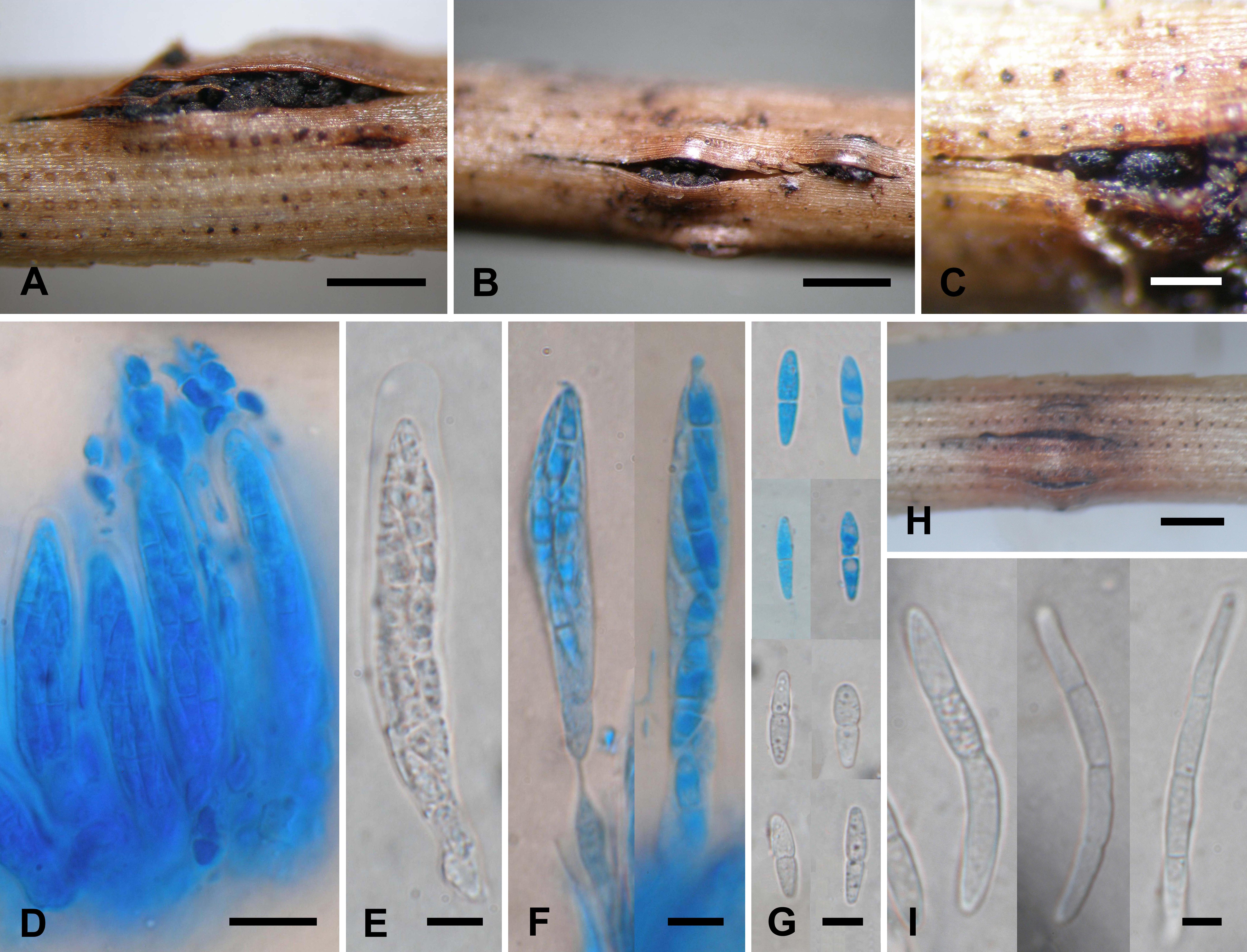 | Adamčíková, K; Pastirčáková, K; Jánošíková, Z; Ostrovský, R; Pastirčák, M; Pažitný, J; Kobza, M; Adamčík, S; Kádasi-Horáková, M; Ondrušková, E New regional records of Dothistroma needle blight pathogens from Slovakia: distribution, hosts and pathogens characterization Journal Article Annals of Forest Research, 66 (1), pp. 99-111, 2023, ISSN: 1844-8135. @article{Adamčíková2023, title = {New regional records of Dothistroma needle blight pathogens from Slovakia: distribution, hosts and pathogens characterization}, author = {K. Adamčíková and K. Pastirčáková and Z. Jánošíková and R. Ostrovský and M. Pastirčák and J. Pažitný and M. Kobza and S. Adamčík and M. Kádasi-Horáková and E. Ondrušková}, doi = {https://doi.org/10.15287/afr.2023.2427}, issn = {1844-8135}, year = {2023}, date = {2023-07-25}, journal = {Annals of Forest Research}, volume = {66}, number = {1}, pages = {99-111}, abstract = {Dothistroma needle blight is one of the most severe needle diseases of pines caused by two closely related species, Dothistroma septosporum and D. pini. The further spread and distribution of this disease was investigated in Slovakia as well as new hosts and stand types were identified at regional level. Dothistroma septosporum was recorded in a natural stand at higher altitude on Pinus cembra in the High Tatras and the P. uncinata records are new host reports for Slovakia for this pathogen. Moreover, for D. pini, P. cembra as a new host at the country level was recorded and P. armandii was identified as new host species worldwide. Mating types for all collected samples and ITS haplotypes for D. pini isolates were determined. For D. pini, five localities with the presence of both mating types and three ITS haplotypes (Dp_HAP.1, Dp_HAP.2 and Dp_HAP.4) were reported. Samples where both mating types of the pathogens were identified, were selected for the microscopic examination of fruiting bodies aimed to detect sexual reproductive organs. In all inspected needle samples of D. pini, only conidiomata with typical hyaline cylindrical conidia were identified. The sexual state of D. septosporum was recorded in one sample of P. nigra needles.}, keywords = {}, pubstate = {published}, tppubtype = {article} } Dothistroma needle blight is one of the most severe needle diseases of pines caused by two closely related species, Dothistroma septosporum and D. pini. The further spread and distribution of this disease was investigated in Slovakia as well as new hosts and stand types were identified at regional level. Dothistroma septosporum was recorded in a natural stand at higher altitude on Pinus cembra in the High Tatras and the P. uncinata records are new host reports for Slovakia for this pathogen. Moreover, for D. pini, P. cembra as a new host at the country level was recorded and P. armandii was identified as new host species worldwide. Mating types for all collected samples and ITS haplotypes for D. pini isolates were determined. For D. pini, five localities with the presence of both mating types and three ITS haplotypes (Dp_HAP.1, Dp_HAP.2 and Dp_HAP.4) were reported. Samples where both mating types of the pathogens were identified, were selected for the microscopic examination of fruiting bodies aimed to detect sexual reproductive organs. In all inspected needle samples of D. pini, only conidiomata with typical hyaline cylindrical conidia were identified. The sexual state of D. septosporum was recorded in one sample of P. nigra needles. |
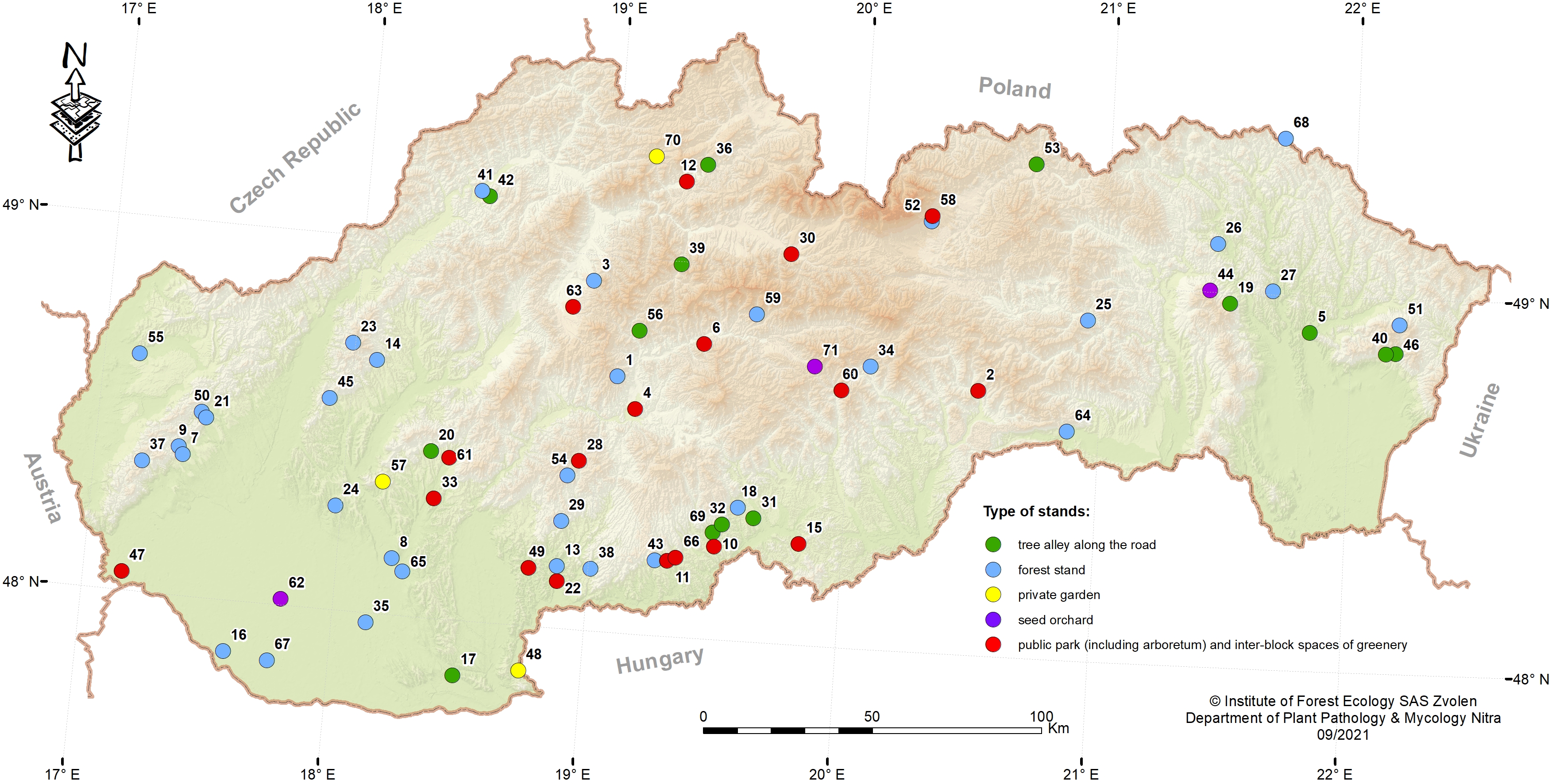 | Kádasi-Horáková, M; Barta, M; Adamčíková, K; Ostrovský, R; Pastirčáková, K Hymenoscyphus fraxineus on Fraxinus excelsior in Slovakia: distribution and mating types Journal Article Biologia, 78 (5), pp. 1219-1230, 2023, ISSN: 0006-3088. @article{Kádasi-Horáková2023, title = {\textit{Hymenoscyphus fraxineus} on \textit{Fraxinus excelsior} in Slovakia: distribution and mating types}, author = {M. Kádasi-Horáková and M. Barta and K. Adamčíková and R. Ostrovský and K. Pastirčáková}, doi = {10.1007/s11756-022-01023-9}, issn = {0006-3088}, year = {2023}, date = {2023-05-10}, journal = {Biologia}, volume = {78}, number = {5}, pages = {1219-1230}, abstract = {Hymenoscyphus fraxineus causes ash dieback in Europe and threatens the future existence of Fraxinus excelsior in large parts of its natural distribution range. In this study, we report the first documented distribution of the pathogen on the most common ash species F. excelsior in Slovakia, identified molecularly using species-specific primers and based on sequencing of the ITS region of rDNA. Analysis of the mating type genes of H. fraxineus isolates revealed the presence of both mating types in Slovakia. Hymenoscyphus fraxineus-positive trees were recorded in 70 localities with different types of management in different parts of the country, mainly in forest stands. The results indicate the widespread distribution of H. fraxineus across the entire country, wherever the host is present.}, keywords = {}, pubstate = {published}, tppubtype = {article} } Hymenoscyphus fraxineus causes ash dieback in Europe and threatens the future existence of Fraxinus excelsior in large parts of its natural distribution range. In this study, we report the first documented distribution of the pathogen on the most common ash species F. excelsior in Slovakia, identified molecularly using species-specific primers and based on sequencing of the ITS region of rDNA. Analysis of the mating type genes of H. fraxineus isolates revealed the presence of both mating types in Slovakia. Hymenoscyphus fraxineus-positive trees were recorded in 70 localities with different types of management in different parts of the country, mainly in forest stands. The results indicate the widespread distribution of H. fraxineus across the entire country, wherever the host is present. |
 | Ondrušková, E; Adamčík, S; Kobza, M; Jánošíková, Z; Ostrovský, R; Pastirčáková, K; Caboň, M; Adamčíková, K Checking the balance between pathogenic and mutualistic pine needle fungi of the genus Lophodermium in forested and urban areas of Slovakia Journal Article Scandinavian Journal of Forest Research, 38 (1-2), pp. 39-48, 2023, ISSN: 1651-1891. @article{Ondrušková2023, title = {Checking the balance between pathogenic and mutualistic pine needle fungi of the genus Lophodermium in forested and urban areas of Slovakia}, author = {E. Ondrušková and S. Adamčík and M. Kobza and Z. Jánošíková and R. Ostrovský and K. Pastirčáková and M. Caboň and K. Adamčíková }, doi = { DOI: 10.1080/02827581.2023.2191004}, issn = {1651-1891}, year = {2023}, date = {2023-03-27}, journal = {Scandinavian Journal of Forest Research}, volume = {38}, number = {1-2}, pages = {39-48}, abstract = {Lophodermium species are well known to be among dominant endophytic fungi colonising pine needles. Occurrence of two species with different life strategies on different Pinus trees across Slovakia was detected by PCR using species specific primers. In general, commensalistic species L. pinastri was more frequent than parasitic L. seditiosum. There were no significant differences observed between urban and natural environments, but natural environments have more frequent colonisation by L. pinastri and less frequent were trees negatively tested to Lophodermium colonisation. Among the most frequently sampled trees were non-native P. nigra and native P. sylvestris. Significant difference in Lophodermium incidence was detected between these two species in natural environment, with increased frequency of L. pinastri on native Scots pine. In addition to one clade of L. pinastri, culture based species identification confirmed presence of L. corconticum and an undescribed clade of L. seditiosum that is not sensitive to used PCR primers for the species detection.}, keywords = {}, pubstate = {published}, tppubtype = {article} } Lophodermium species are well known to be among dominant endophytic fungi colonising pine needles. Occurrence of two species with different life strategies on different Pinus trees across Slovakia was detected by PCR using species specific primers. In general, commensalistic species L. pinastri was more frequent than parasitic L. seditiosum. There were no significant differences observed between urban and natural environments, but natural environments have more frequent colonisation by L. pinastri and less frequent were trees negatively tested to Lophodermium colonisation. Among the most frequently sampled trees were non-native P. nigra and native P. sylvestris. Significant difference in Lophodermium incidence was detected between these two species in natural environment, with increased frequency of L. pinastri on native Scots pine. In addition to one clade of L. pinastri, culture based species identification confirmed presence of L. corconticum and an undescribed clade of L. seditiosum that is not sensitive to used PCR primers for the species detection. |
2022 |
|
 | Barta, M; Pastirčáková, K; Ostrovský, R; Kobza, M; Kádasi-Horáková, M Culturable endophytic fungi in Fraxinus excelsior and their interactions with Hymenoscyphus fraxineus Journal Article Forests, 13 (7), pp. 1-23, Article no. 1098, 2022, ISSN: 1999-4907. @article{Barta2022b, title = {Culturable endophytic fungi in \textit{Fraxinus excelsior} and their interactions with \textit{Hymenoscyphus fraxineus}}, author = {M. Barta and K. Pastirčáková and R. Ostrovský and M. Kobza and M. Kádasi-Horáková}, doi = {10.3390/f13071098}, issn = {1999-4907}, year = {2022}, date = {2022-07-13}, journal = {Forests}, volume = {13}, number = {7}, pages = {1-23, Article no. 1098}, abstract = {The species diversity of culturable endophytic fungi was studied in the leaves and twigs of symptomatic and asymptomatic Fraxinus excelsior trees. Endophytic mycobiota was dominated by Ascomycota species, with Pleosporales (44.17%) and Diaporthales (23.79%) endophytes being the most frequently observed in the tree samples. The number of endophytic isolates and species richness varied depending on the sampling date (May and October) and tissue location. Of the 54 species identified based on ITS sequences, 14 were classified as dominant. The most frequently isolated species were Diaporthe eres, followed by Alternaria alternata, Dothiorella gregaria, and Fraxinicola fraxini. The inhibitory effect of 41 species (75 isolates) of endophytes on the radial growth of a Hymenoscyphus fraxineus isolate was studied under in vitro conditions (dual cultures). The radial growth of H. fraxineus was the most inhibited by four endophytic fungi from twigs (Fusarium lateritium, Didymella aliena, Didymella macrostoma, and Dothiorella gregaria). The inhibitory effect of the four isolates was also studied under in planta conditions. The isolates artificially inoculated into the trunks of ash trees reduced the length of necroses formed by H. fraxineus co-inoculated in the same trunks. This effect depended on the isolate, and the inhibition was most prominent only on trunks inoculated with F. lateritium and D. aliena. Although the total length of necrotic lesions formed by the H. fraxineus infection was shorter in the ash trunks co-inoculated with the endophytes, the difference was not significant.}, keywords = {}, pubstate = {published}, tppubtype = {article} } The species diversity of culturable endophytic fungi was studied in the leaves and twigs of symptomatic and asymptomatic Fraxinus excelsior trees. Endophytic mycobiota was dominated by Ascomycota species, with Pleosporales (44.17%) and Diaporthales (23.79%) endophytes being the most frequently observed in the tree samples. The number of endophytic isolates and species richness varied depending on the sampling date (May and October) and tissue location. Of the 54 species identified based on ITS sequences, 14 were classified as dominant. The most frequently isolated species were Diaporthe eres, followed by Alternaria alternata, Dothiorella gregaria, and Fraxinicola fraxini. The inhibitory effect of 41 species (75 isolates) of endophytes on the radial growth of a Hymenoscyphus fraxineus isolate was studied under in vitro conditions (dual cultures). The radial growth of H. fraxineus was the most inhibited by four endophytic fungi from twigs (Fusarium lateritium, Didymella aliena, Didymella macrostoma, and Dothiorella gregaria). The inhibitory effect of the four isolates was also studied under in planta conditions. The isolates artificially inoculated into the trunks of ash trees reduced the length of necroses formed by H. fraxineus co-inoculated in the same trunks. This effect depended on the isolate, and the inhibition was most prominent only on trunks inoculated with F. lateritium and D. aliena. Although the total length of necrotic lesions formed by the H. fraxineus infection was shorter in the ash trunks co-inoculated with the endophytes, the difference was not significant. |
 | Kobza, M; Ostrovský, R; Adamčíková, K; Pastirčáková, K Stability of trees infected by wood decay fungi estimated by acoustic tomography: a field survey Journal Article Trees Structure and Function, 36 (1), pp. 103-112, 2022, ISSN: 1432-2285. @article{Kobza2022, title = {Stability of trees infected by wood decay fungi estimated by acoustic tomography: a field survey}, author = {M. Kobza and R. Ostrovský and K. Adamčíková and K. Pastirčáková}, url = {https://doi.org/10.1007/s00468-021-02185-w}, doi = {10.1007/s00468-021-02185-w}, issn = {1432-2285}, year = {2022}, date = {2022-02-08}, journal = {Trees Structure and Function}, volume = {36}, number = {1}, pages = {103-112}, abstract = {In this survey, we assessed the relationships between the presence of visible fruiting bodies and measurements of both wood damage and tree safety factor (SF), the final aim being the determination of whether a tree showing wood decay signs should be felled or not. In general, trees affected by wood-decaying fungi cannot be considered risky prior to determining the impact of the fungi on their structural integrity. Trees of nine genera from 13 localities of Slovakia were included in this survey. In total, nineteen species of fungi were found causing wood decay on 74 individual host trees. Acoustic tomography was done using a Fakopp 3D tomograph, and SF was calculated by ArborSonic 3D software. The most commonly occurring taxon, Fomes fomentarius (L.) Fr., was found on six tree genera. The highest degree of damaged area on trunks was caused by fungi in the genera Fomes, Ganoderma, and Perenniporia (over 70%), while the lowest damage was caused by genera Spongipellis, Cerrena, and Auricularia (up to 30%). The lowest values of SF were measured on trees of the genus Acer infected by Fomes fomentarius; Prunus infected by Phellinus pomaceus (Pers.) Maire; and Fagus infected by Ganoderma pfeifferi Bres. Computation of the SF of individual trees plays a vital part in the stability evaluation of trees affected by wood decay fungi.}, keywords = {}, pubstate = {published}, tppubtype = {article} } In this survey, we assessed the relationships between the presence of visible fruiting bodies and measurements of both wood damage and tree safety factor (SF), the final aim being the determination of whether a tree showing wood decay signs should be felled or not. In general, trees affected by wood-decaying fungi cannot be considered risky prior to determining the impact of the fungi on their structural integrity. Trees of nine genera from 13 localities of Slovakia were included in this survey. In total, nineteen species of fungi were found causing wood decay on 74 individual host trees. Acoustic tomography was done using a Fakopp 3D tomograph, and SF was calculated by ArborSonic 3D software. The most commonly occurring taxon, Fomes fomentarius (L.) Fr., was found on six tree genera. The highest degree of damaged area on trunks was caused by fungi in the genera Fomes, Ganoderma, and Perenniporia (over 70%), while the lowest damage was caused by genera Spongipellis, Cerrena, and Auricularia (up to 30%). The lowest values of SF were measured on trees of the genus Acer infected by Fomes fomentarius; Prunus infected by Phellinus pomaceus (Pers.) Maire; and Fagus infected by Ganoderma pfeifferi Bres. Computation of the SF of individual trees plays a vital part in the stability evaluation of trees affected by wood decay fungi. |
2021 |
|
 | Adamčíková, K; Jánošíková, Z; Adamčík, S; Ostrovský, R; Pastirčáková, K; Kobza, M; Ondrušková, E Host range, genetic variability, and mating types of Lecanosticta acicola in Slovakia Journal Article Scandinavian Journal of Forest Research, 36 (5), pp. 325-332, 2021, ISSN: 0282-7581. @article{Adamčíková2021b, title = {Host range, genetic variability, and mating types of \textit{Lecanosticta acicola} in Slovakia}, author = {K. Adamčíková and Z. Jánošíková and S. Adamčík and R. Ostrovský and K. Pastirčáková and M. Kobza and E. Ondrušková}, url = {https://doi.org/10.1080/02827581.2021.1941236}, doi = {10.1080/02827581.2021.1941236}, issn = {0282-7581}, year = {2021}, date = {2021-07-16}, journal = {Scandinavian Journal of Forest Research}, volume = {36}, number = {5}, pages = {325-332}, abstract = {In recent years, there has been an apparent Europe-wide emerging presence of brown spot needle blight, a disease of pine species caused by the fungus Lecanosticta acicola. In this study, we report the first well-documented occurrences of the pathogen in Slovakia, identified molecularly using species-specific primers and based on sequencing of the ITS region and TEF1 gene. Among the material collected from 84 locations within the country, L. acicola was present in 17 samples from 13 different locations, mainly distributed in urban environments. Four pine species were identified as hosts, among which, Pinus nigra and P. mugo were found to be the most frequently infected. Analysis of the mating type genes of 24 isolates obtained from two localities revealed the presence of a single mating type in Slovakia. All analyzed ITS sequences of the Slovak isolates were found to be uniform. However, although analysis of the TEF1 gene indicated that all Slovak isolates could be grouped into a single lineage, we detected nucleotide polymorphisms suggestive of a certain degree of genetic diversification within central European populations of the fungus.}, keywords = {}, pubstate = {published}, tppubtype = {article} } In recent years, there has been an apparent Europe-wide emerging presence of brown spot needle blight, a disease of pine species caused by the fungus Lecanosticta acicola. In this study, we report the first well-documented occurrences of the pathogen in Slovakia, identified molecularly using species-specific primers and based on sequencing of the ITS region and TEF1 gene. Among the material collected from 84 locations within the country, L. acicola was present in 17 samples from 13 different locations, mainly distributed in urban environments. Four pine species were identified as hosts, among which, Pinus nigra and P. mugo were found to be the most frequently infected. Analysis of the mating type genes of 24 isolates obtained from two localities revealed the presence of a single mating type in Slovakia. All analyzed ITS sequences of the Slovak isolates were found to be uniform. However, although analysis of the TEF1 gene indicated that all Slovak isolates could be grouped into a single lineage, we detected nucleotide polymorphisms suggestive of a certain degree of genetic diversification within central European populations of the fungus. |
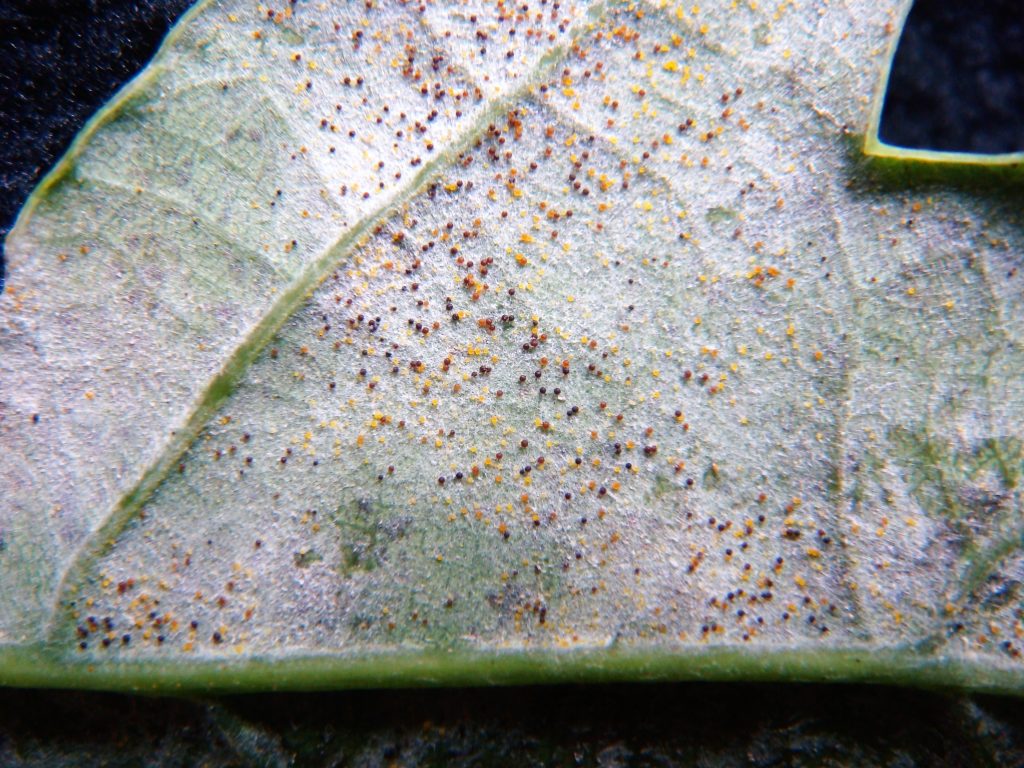 | Pastirčáková, K; Adamčík, S; Adamčíková, K; Chater, A O Erysiphe hypophylla, a second powdery mildew (Erysiphales) on oaks in Britain Journal Article Field Mycology, 22 (2), pp. 50-54, 2021, ISSN: 1468-1641. @article{Pastirčáková2021b, title = {\textit{Erysiphe hypophylla}, a second powdery mildew (\textit{Erysiphales}) on oaks in Britain}, author = {K. Pastirčáková and S. Adamčík and K. Adamčíková and A.O. Chater}, doi = {10.1016/j.fldmyc.2021.04.008}, issn = {1468-1641}, year = {2021}, date = {2021-04-20}, journal = {Field Mycology}, volume = {22}, number = {2}, pages = {50-54}, keywords = {}, pubstate = {published}, tppubtype = {article} } |
Pastirčáková, Katarína; Adamčíková, Katarína; Bacigálová, Kamila; Caboň, Miroslav; Mikušová, Petra; Senko, Dušan; Svitok, Marek; Adamčík, Slavomír Ash Trees (Fraxinus spp.) in Urban Greenery as Possible Invasion Gates of Non-Native Phyllactinia Species Journal Article Forests, 12 (2), pp. 183, 2021, ISSN: 1999-4907. @article{Pastir_kov__2021, title = {Ash Trees (Fraxinus spp.) in Urban Greenery as Possible Invasion Gates of Non-Native Phyllactinia Species}, author = {Katarína Pastirčáková and Katarína Adamčíková and Kamila Bacigálová and Miroslav Caboň and Petra Mikušová and Dušan Senko and Marek Svitok and Slavomír Adamčík}, url = {http://dx.doi.org/10.3390/f12020183}, doi = {10.3390/f12020183}, issn = {1999-4907}, year = {2021}, date = {2021-01-01}, journal = {Forests}, volume = {12}, number = {2}, pages = {183}, publisher = {MDPI AG}, keywords = {}, pubstate = {published}, tppubtype = {article} } | |
2020 |
|
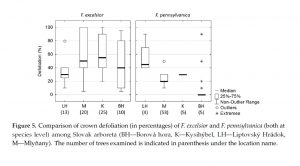 | Pastirčáková, K; Adamčíková, K; Barta, M; Pažitný, J; Hoťka, P; Sarvašová, I; Kádasi-Horáková, M Host range of Hymenoscyphus fraxineus in Slovak arboreta Journal Article Forests, 11 (5), pp. 1-18, Article Number: 596, 2020, ISSN: 1999-4907. @article{Pastirčáková25.0, title = {Host range of \textit{Hymenoscyphus fraxineus} in Slovak arboreta}, author = {K. Pastirčáková and K. Adamčíková and M. Barta and J. Pažitný and P. Hoťka and I. Sarvašová and M. Kádasi-Horáková}, doi = {10.3390/f11050596}, issn = {1999-4907}, year = {2020}, date = {2020-05-25}, journal = {Forests}, volume = {11}, number = {5}, pages = {1-18, Article Number: 596}, abstract = {The health of 34 different Fraxinus taxa in association with the pathogenic fungus Hymenoscyphus fraxineus was assessed in four Slovak arboreta. Averaged across all arboreta, nearly one-quarter (24.9%) of all evaluated trees showed ash dieback symptoms. The damage was most serious on the common ash F. excelsior, a native species. The percentage of dead trees did not exceed 2% for all evaluated trees. Generally, ash trees of all ages were affected, though the intensity of the damage varied among the sites. The identity of H. fraxineus was confirmed by conventional PCR targeting the internal transcribed spacer (ITS) sequences of the nuclear ribosomal DNA, as well as the 18S gene/ITS-2 region of the rDNA operon. In Slovakia, the pathogen has expanded its host range from native species not only to their ornamental cultivars, but also to introduced North American (F. cinerea, F. latifolia, F. pennsylvanica, F. quadrangulata) and Asian (F. bungeana, F. chinensis ssp. rhynchophylla, F. mandshurica) ash species. H. fraxineus was also observed on the previous year’s leaf petioles of the native European species F. ornus, considered a weakly susceptible host. In Slovak arboreta, H. fraxineus was found on 23 Fraxinus taxa; 21 of them represent first records for the country. F. bungeana is recorded as a new host species of H. fraxineus.}, keywords = {}, pubstate = {published}, tppubtype = {article} } The health of 34 different Fraxinus taxa in association with the pathogenic fungus Hymenoscyphus fraxineus was assessed in four Slovak arboreta. Averaged across all arboreta, nearly one-quarter (24.9%) of all evaluated trees showed ash dieback symptoms. The damage was most serious on the common ash F. excelsior, a native species. The percentage of dead trees did not exceed 2% for all evaluated trees. Generally, ash trees of all ages were affected, though the intensity of the damage varied among the sites. The identity of H. fraxineus was confirmed by conventional PCR targeting the internal transcribed spacer (ITS) sequences of the nuclear ribosomal DNA, as well as the 18S gene/ITS-2 region of the rDNA operon. In Slovakia, the pathogen has expanded its host range from native species not only to their ornamental cultivars, but also to introduced North American (F. cinerea, F. latifolia, F. pennsylvanica, F. quadrangulata) and Asian (F. bungeana, F. chinensis ssp. rhynchophylla, F. mandshurica) ash species. H. fraxineus was also observed on the previous year’s leaf petioles of the native European species F. ornus, considered a weakly susceptible host. In Slovak arboreta, H. fraxineus was found on 23 Fraxinus taxa; 21 of them represent first records for the country. F. bungeana is recorded as a new host species of H. fraxineus. |
2019 |
|
 | Pastirčáková, K In vitro interactions between Trichoderma harzianum and pathogenic fungi damaging horse-chestnut (Aesculus hippocastanum) leaves and fruits Journal Article Biological Letters, 54 (1), pp. 21-35, 2019, ISSN: 1644-7700. @article{Pastirčáková2019, title = {\textit{In vitro} interactions between \textit{Trichoderma harzianum} and pathogenic fungi damaging horse-chestnut (\textit{Aesculus hippocastanum}) leaves and fruits}, author = {K. Pastirčáková}, doi = {10.2478/biolet-2019-0003}, issn = {1644-7700}, year = {2019}, date = {2019-08-06}, journal = {Biological Letters}, volume = {54}, number = {1}, pages = {21-35}, abstract = {Interactions between 3 pathogenic fungi damaging horse-chestnut (Aesculus hippocastanum) leaves and fruits – Phyllosticta sphaeropsoidea, Phomopsis carposchiza, and Diaporthe padi – and the antagonistic fungus Trichoderma harzianum were studied to determine their mutual influence in vitro. Antibiosis of colonies developing on 5 nutrient media was tested. The 3 studied T. harzianum isolates differed in their antagonistic potential. Although T. harzianum isolates significantly inhibited the growth of Phomopsis carposchiza, the mycelium growth of some of the re-isolates on fresh medium indicates an inadequate antagonistic effect of T. harzianum on this species. The tested Trichoderma isolates showed stronger antagonism towards the other pathogens, reflected in overgrowing of Phyllosticta sphaeropsoidea and Diaporthe padi and reducing their growth. Granulation of the cytoplasm and lysis of hyphae of the fungal pathogens were the most frequently observed effects of the interaction.}, keywords = {}, pubstate = {published}, tppubtype = {article} } Interactions between 3 pathogenic fungi damaging horse-chestnut (Aesculus hippocastanum) leaves and fruits – Phyllosticta sphaeropsoidea, Phomopsis carposchiza, and Diaporthe padi – and the antagonistic fungus Trichoderma harzianum were studied to determine their mutual influence in vitro. Antibiosis of colonies developing on 5 nutrient media was tested. The 3 studied T. harzianum isolates differed in their antagonistic potential. Although T. harzianum isolates significantly inhibited the growth of Phomopsis carposchiza, the mycelium growth of some of the re-isolates on fresh medium indicates an inadequate antagonistic effect of T. harzianum on this species. The tested Trichoderma isolates showed stronger antagonism towards the other pathogens, reflected in overgrowing of Phyllosticta sphaeropsoidea and Diaporthe padi and reducing their growth. Granulation of the cytoplasm and lysis of hyphae of the fungal pathogens were the most frequently observed effects of the interaction. |
Pastirčáková, Katarína In vitro interactions between Trichoderma harzianum and pathogenic fungi damaging horse-chestnut (Aesculus hippocastanum) leaves and fruits Journal Article Biological Letters, 54 (1), pp. 24-35, 2019, ISSN: 1644-7700. @article{Pastirčáková2019b, title = {\textit{In vitro} interactions between \textit{Trichoderma harzianum} and pathogenic fungi damaging horse-chestnut (\textit{Aesculus hippocastanum}) leaves and fruits}, author = {Katarína Pastirčáková}, doi = {10.2478/biolet-2019-0003}, issn = {1644-7700}, year = {2019}, date = {2019-08-02}, journal = {Biological Letters}, volume = {54}, number = {1}, pages = {24-35}, abstract = {Interactions between 3 pathogenic fungi damaging horse-chestnut (Aesculus hippocastanum) leaves and fruits – Phyllosticta sphaeropsoidea, Phomopsis carposchiza, and Diaporthe padi – and the antagonistic fungus Trichoderma harzianum were studied to determine their mutual influence in vitro. Antibiosis of colonies developing on 5 nutrient media was tested. The 3 studied T. harzianum isolates differed in their antagonistic potential. although T. harzianum isolates significantly inhibited the growth of Phomopsis carposchiza, the mycelium growth of some of the re-isolates on fresh medium indicates an inadequate antagonistic effect of T. harzianum on this species. The tested Trichoderma isolates showed stronger antagonism towards the other pathogens, reflected in overgrowing of Phyllosticta sphaeropso-idea and Diaporthe padi and reducing their growth. Granulation of the cytoplasm and lysis of hyphae of the fungal pathogens were the most frequently observed effects of the interaction.}, keywords = {}, pubstate = {published}, tppubtype = {article} } Interactions between 3 pathogenic fungi damaging horse-chestnut (Aesculus hippocastanum) leaves and fruits – Phyllosticta sphaeropsoidea, Phomopsis carposchiza, and Diaporthe padi – and the antagonistic fungus Trichoderma harzianum were studied to determine their mutual influence in vitro. Antibiosis of colonies developing on 5 nutrient media was tested. The 3 studied T. harzianum isolates differed in their antagonistic potential. although T. harzianum isolates significantly inhibited the growth of Phomopsis carposchiza, the mycelium growth of some of the re-isolates on fresh medium indicates an inadequate antagonistic effect of T. harzianum on this species. The tested Trichoderma isolates showed stronger antagonism towards the other pathogens, reflected in overgrowing of Phyllosticta sphaeropso-idea and Diaporthe padi and reducing their growth. Granulation of the cytoplasm and lysis of hyphae of the fungal pathogens were the most frequently observed effects of the interaction. | |
2018 |
|
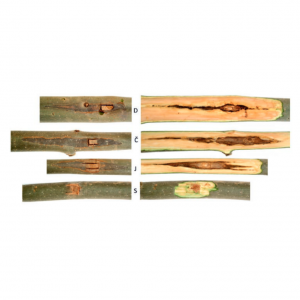 | Adamčíková, K; Pažitný, J; Pastirčáková, K Individual resistance of Fraxinus angustifolia and F. excelsior clones to Hymenoscyphus fraxineus Journal Article Journal of Plant Protection Research, 58 (3), pp. 227-233, 2018, ISSN: 1427-4345. @article{Adamčíková2018, title = {Individual resistance of \textit{Fraxinus angustifolia} and \textit{F. excelsior} clones to \textit{Hymenoscyphus fraxineus}}, author = {K. Adamčíková and J. Pažitný and K. Pastirčáková}, doi = {10.24425/122937}, issn = {1427-4345}, year = {2018}, date = {2018-10-22}, journal = {Journal of Plant Protection Research}, volume = {58}, number = {3}, pages = {227-233}, abstract = {Ash dieback, caused by Hymenoscyphus fraxineus, is a serious disease of common and narrow-leaved ash in Europe. The resistance of individual trees seems to be important for the maintenance of ash in European forests. In this in situ wound inoculation study, the susceptibility and differences in resistance to H. fraxineus between Fraxinus excelsior and F. angustifolia clones were assessed. Neither of the tested clones revealed total resistance to ash dieback; variety between the tested clones was observed. Differences in necroses lengths were significant between clones and between two ash species. Longer necroses were formed in F. angustifolia than in F. excelsior. Some clones exhibiting some resistance to the pathogen were identified. }, keywords = {}, pubstate = {published}, tppubtype = {article} } Ash dieback, caused by Hymenoscyphus fraxineus, is a serious disease of common and narrow-leaved ash in Europe. The resistance of individual trees seems to be important for the maintenance of ash in European forests. In this in situ wound inoculation study, the susceptibility and differences in resistance to H. fraxineus between Fraxinus excelsior and F. angustifolia clones were assessed. Neither of the tested clones revealed total resistance to ash dieback; variety between the tested clones was observed. Differences in necroses lengths were significant between clones and between two ash species. Longer necroses were formed in F. angustifolia than in F. excelsior. Some clones exhibiting some resistance to the pathogen were identified. |
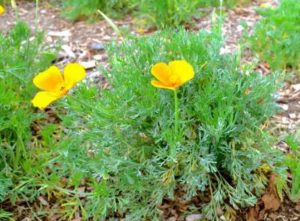 | Camacho-Tapia, M; Sánchez-Soto, V; Correia, K C; Pastirčáková, K; Tovar-Pedraza, J M Powdery mildew of California poppy caused by Erysiphe eschscholziae in Mexico Journal Article Canadian Journal of Plant Pathology, 40 (3), pp. 461-466, 2018, ISSN: 0706-0661 . @article{Camacho-Tapia2018, title = {Powdery mildew of California poppy caused by \textit{Erysiphe eschscholziae} in Mexico}, author = {M. Camacho-Tapia and V. Sánchez-Soto and K.C. Correia and K. Pastirčáková and J.M. Tovar-Pedraza}, doi = {10.1080/07060661.2018.1498807}, issn = {0706-0661 }, year = {2018}, date = {2018-10-02}, journal = {Canadian Journal of Plant Pathology}, volume = {40}, number = {3}, pages = {461-466}, abstract = {Severe infection by powdery mildew was observed on California poppy (Eschscholzia californica) plants in Texcoco, State of Mexico, during spring of 2014 to 2017. Symptoms included colonies of white to greyish mildew-like growth on the abaxial and adaxial surfaces of the leaves. The identification of the fungal species was performed by examination of morphological structures using light microscopy and scanning electronmicroscope (SEM), as well as sequence analysis of the 5ʹ-end of 28S rRNA gene and the internal transcribed spacer (ITS) region of rDNA. Using the combination of morphological characterization and a phylogenetic analysis using Bayesian inference, the fungal agent was identified as Erysiphe eschscholziae. Pathogenicity tests were conducted on leaves of California poppy plants, and Koch’s postulates were fulfilled. This is the first report of E. eschscholziae causing powdery mildew on Eschscholzia californica in Mexico.}, keywords = {}, pubstate = {published}, tppubtype = {article} } Severe infection by powdery mildew was observed on California poppy (Eschscholzia californica) plants in Texcoco, State of Mexico, during spring of 2014 to 2017. Symptoms included colonies of white to greyish mildew-like growth on the abaxial and adaxial surfaces of the leaves. The identification of the fungal species was performed by examination of morphological structures using light microscopy and scanning electronmicroscope (SEM), as well as sequence analysis of the 5ʹ-end of 28S rRNA gene and the internal transcribed spacer (ITS) region of rDNA. Using the combination of morphological characterization and a phylogenetic analysis using Bayesian inference, the fungal agent was identified as Erysiphe eschscholziae. Pathogenicity tests were conducted on leaves of California poppy plants, and Koch’s postulates were fulfilled. This is the first report of E. eschscholziae causing powdery mildew on Eschscholzia californica in Mexico. |
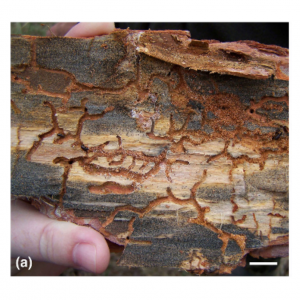 | Pastirčáková, K; Adamčíková, K; Pastirčák, M; Zach, P; Galko, J; Kováč, M; Laco, J Two blue-stain fungi colonizing Scots pine (Pinus sylvestris) trees infested by bark beetles in Slovakia, Central Europe Journal Article Biologia, 73 (11), pp. 1053-1066, 2018, ISSN: 0006-3088. @article{Pastirčáková2018c, title = {Two blue-stain fungi colonizing Scots pine (\textit{Pinus sylvestris}) trees infested by bark beetles in Slovakia, Central Europe}, author = {K. Pastirčáková and K. Adamčíková and M. Pastirčák and P. Zach and J. Galko and M. Kováč and J. Laco}, doi = {10.2478/s11756-018-0114-6}, issn = {0006-3088}, year = {2018}, date = {2018-09-17}, journal = {Biologia}, volume = {73}, number = {11}, pages = {1053-1066}, abstract = {Excessive mortality of Scots pine (Pinus sylvestris) trees has recently been observed in the Záhorská nížina lowland in western Slovakia, Central Europe. Continuous drought, bark beetles and blue-stain fungi are likely to play a crucial role in this dieback of pines in a warm sandy area. Two blue-stain fungi, Ophiostoma ips and Ophiostoma minus, were found here on Scots pine trunks infested by bark beetles. These fungi were isolated and identified based on morphological properties and DNA sequences (ITS, LSU, β-tubulin). They colonized the inner bark, phloem and blue-stained sapwood, and were recorded in the galleries of Orthotomicus longicollis and other species of this genus. The occurrence of O. minus was massive; the fungus was found to produce perithecia abundantly in dying pines. Detailed descriptions, illustrations and global distribution of the two fungal species on host pine species are provided. The records of O. ips and those of O. minus are new for the mycoflora of Slovakia. Undetermined mycophagous nematodes were found inside the perithecia of O. ips. The role of bark beetles as real and potential vectors (Ips spp., Orthotomicus spp., Tomicus spp., Hylurgus ligniperda, Hylastes sp.) of blue-stain fungi in a declining pine forest is discussed.}, keywords = {}, pubstate = {published}, tppubtype = {article} } Excessive mortality of Scots pine (Pinus sylvestris) trees has recently been observed in the Záhorská nížina lowland in western Slovakia, Central Europe. Continuous drought, bark beetles and blue-stain fungi are likely to play a crucial role in this dieback of pines in a warm sandy area. Two blue-stain fungi, Ophiostoma ips and Ophiostoma minus, were found here on Scots pine trunks infested by bark beetles. These fungi were isolated and identified based on morphological properties and DNA sequences (ITS, LSU, β-tubulin). They colonized the inner bark, phloem and blue-stained sapwood, and were recorded in the galleries of Orthotomicus longicollis and other species of this genus. The occurrence of O. minus was massive; the fungus was found to produce perithecia abundantly in dying pines. Detailed descriptions, illustrations and global distribution of the two fungal species on host pine species are provided. The records of O. ips and those of O. minus are new for the mycoflora of Slovakia. Undetermined mycophagous nematodes were found inside the perithecia of O. ips. The role of bark beetles as real and potential vectors (Ips spp., Orthotomicus spp., Tomicus spp., Hylurgus ligniperda, Hylastes sp.) of blue-stain fungi in a declining pine forest is discussed. |
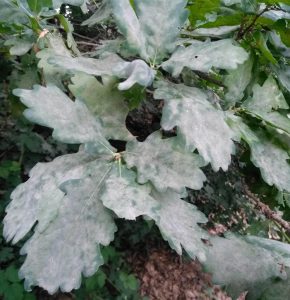 | Desprez-Loustau, M L; Massot, M; Toïgo, M; Fort, T; Aday_Kaya, A G; Boberg, J; Braun, U; Capdevielle, X; Cech, T; Chandelier, A; Christova, P; Corcobado, T; Dogmus, T; Dutech, C; Fabreguettes, O; Faivre_d'Arcier, J; Gross, A; Horta_Jung, M; Iturrixa, E; Jung, T; Junker, C; Kiss, L; Kostov, K; Lehtijarvi, A; Lyubenova, A; Marçais, B; Oliva, J; Oskay, F; Pastirčák, M; Pastirčáková, K; Piou, D; Saint-Jean, G; Sallafranque, A; Slavov, S; Stenlid, J; Talgø, V; Takamatsu, T; Tack, A J M From leaf to continent: The multi-scale distribution of an invasive cryptic pathogen complex on oak Journal Article Fungal Ecology, 36 , pp. 39-50, 2018, ISSN: 1754-5048. @article{Desprez-Loustau2018, title = {From leaf to continent: The multi-scale distribution of an invasive cryptic pathogen complex on oak}, author = {M.L. Desprez-Loustau and M. Massot and M. Toïgo and T. Fort and A.G. Aday_Kaya and J. Boberg and U. Braun and X. Capdevielle and T. Cech and A. Chandelier and P. Christova and T. Corcobado and T. Dogmus and C. Dutech and O. Fabreguettes and J. Faivre_d'Arcier and A. Gross and M. Horta_Jung and E. Iturrixa and T. Jung and C. Junker and L. Kiss and K. Kostov and A. Lehtijarvi and A. Lyubenova and B. Marçais and J. Oliva and F. Oskay and M. Pastirčák and K. Pastirčáková and D. Piou and G. Saint-Jean and A. Sallafranque and S. Slavov and J. Stenlid and V. Talgø and T. Takamatsu and A.J.M. Tack}, doi = {10.1016/j.funeco.2018.08.001}, issn = {1754-5048}, year = {2018}, date = {2018-09-14}, journal = {Fungal Ecology}, volume = {36}, pages = {39-50}, abstract = {The spatial distribution and niche differentiation of three closely related species (Erysiphe alphitoides, Erysiphe quercicola and Erysiphe hypophylla) causing oak powdery mildew was studied at scales ranging from the European continent, where they are invasive, to a single leaf. While E. alphitoides was dominant at all scales, E. quercicola and E. hypophylla had restricted geographic, stand and leaf distributions. The large-scale distributions were likely explained by climatic factors and species environmental tolerances, with E. quercicola being more frequent in warmer climates and E. hypophylla in colder climates. The extensive sampling and molecular analyses revealed the cryptic invasion of E. quercicola in nine countries from which it had not previously been recorded. The presence of the three species was also strongly affected by host factors, such as oak species and developmental stage. Segregation patterns between Erysiphe species were observed at the leaf scale, between and within leaf surfaces, suggesting competitive effects.}, keywords = {}, pubstate = {published}, tppubtype = {article} } The spatial distribution and niche differentiation of three closely related species (Erysiphe alphitoides, Erysiphe quercicola and Erysiphe hypophylla) causing oak powdery mildew was studied at scales ranging from the European continent, where they are invasive, to a single leaf. While E. alphitoides was dominant at all scales, E. quercicola and E. hypophylla had restricted geographic, stand and leaf distributions. The large-scale distributions were likely explained by climatic factors and species environmental tolerances, with E. quercicola being more frequent in warmer climates and E. hypophylla in colder climates. The extensive sampling and molecular analyses revealed the cryptic invasion of E. quercicola in nine countries from which it had not previously been recorded. The presence of the three species was also strongly affected by host factors, such as oak species and developmental stage. Segregation patterns between Erysiphe species were observed at the leaf scale, between and within leaf surfaces, suggesting competitive effects. |
 | Pastirčáková, K; Ostrovský, R; Pastirčák, M Mycobiota in dead and damaged branches of silver birch in Slovakia Journal Article Baltic Forestry, 24 (1), pp. 17-23, 2018, ISSN: 1392-1355. @article{Pastirčáková2018b, title = {Mycobiota in dead and damaged branches of silver birch in Slovakia}, author = {K. Pastirčáková and R. Ostrovský and M. Pastirčák}, url = {https://www.balticforestry.mi.lt/bf/PDF_Articles/2018-24%5B1%5D/Baltic%20Forestry%202018.1_017-023.pdf}, issn = {1392-1355}, year = {2018}, date = {2018-08-23}, journal = {Baltic Forestry}, volume = {24}, number = {1}, pages = {17-23}, abstract = {The species composition of the mycobiota in dead and damaged branches of silver birch (Betula pendula) was studied. The study material collected at 44 localities in Slovakia during the period of 2009 to 2015 was examined. In total, 27 fungal taxa (11 Ascomycetes and 16 Deuteromycetes) were identified on the basis of fruiting body morphology. Sixteen of them have never been recorded on birch trees in the country. Prosthemium betulinum, Trimmatostroma betulinum, Cytospora betulicola, Cryptosporella betulae, Coryneum lanciforme, Myxocyclus polycystis, Pleomassaria siparia, and Disculina betulina were the dominant colonisers of dead branches. The spectrum of fungi colonising dead and dying branches of B. pendula was compared in the following different types of stands: public parks and inter-block spaces of greenery, private gardens, forests, and tree alleys alongside roads. The average number of fungal taxa on birch trees growing in different habitats was not significantly different.}, keywords = {}, pubstate = {published}, tppubtype = {article} } The species composition of the mycobiota in dead and damaged branches of silver birch (Betula pendula) was studied. The study material collected at 44 localities in Slovakia during the period of 2009 to 2015 was examined. In total, 27 fungal taxa (11 Ascomycetes and 16 Deuteromycetes) were identified on the basis of fruiting body morphology. Sixteen of them have never been recorded on birch trees in the country. Prosthemium betulinum, Trimmatostroma betulinum, Cytospora betulicola, Cryptosporella betulae, Coryneum lanciforme, Myxocyclus polycystis, Pleomassaria siparia, and Disculina betulina were the dominant colonisers of dead branches. The spectrum of fungi colonising dead and dying branches of B. pendula was compared in the following different types of stands: public parks and inter-block spaces of greenery, private gardens, forests, and tree alleys alongside roads. The average number of fungal taxa on birch trees growing in different habitats was not significantly different. |
 | Pastirčáková, K; Ivanová, H; Pastirčák, M Species diversity of fungi on damaged branches and leaves of ashes (Fraxinus spp.) in different types of stands in Slovakia Journal Article Central European Forestry Journal, 64 (2), pp. 133-139, 2018, ISSN: 0323-1046. @article{Pastirčáková2018, title = {Species diversity of fungi on damaged branches and leaves of ashes (\textit{Fraxinus} spp.) in different types of stands in Slovakia}, author = {K. Pastirčáková and H. Ivanová and M. Pastirčák}, url = {https://content.sciendo.com/view/journals/forj/64/2/article-p133.xml}, doi = {10.1515/forj-2017-0035}, issn = {0323-1046}, year = {2018}, date = {2018-04-16}, journal = {Central European Forestry Journal}, volume = {64}, number = {2}, pages = {133-139}, abstract = {The diversity of fungi on branches and leaves of ashes (Fraxinus angustifolia, F. excelsior, F. ornus) in Slovakia was studied. Symptomatic material collected in Slovakia during the period of 2013 to 2017 and herbarium specimens previously collected were examined. In total, 30 fungal taxa (15 Deuteromycetes, 14 Ascomycetes and one Basidiomycetes) were recorded. Twenty-three of them have never been recorded on ashes in the country. The most frequently occurring fungi were Hymenoscyphus fraxineus (anamorph Chalara fraxinea) that causes necrosis of shoots and branches, and Phyllactinia fraxini, a foliar pathogen that causes powdery mildew disease. Fungal diversity on ashes growing in different types of stands was compared. Species richness was the greatest in seed orchards (20 fungal taxa) compared to private gardens, which contained the lowest (two fungal taxa). Species diversity in forest stands comprised 18 fungal taxa and the urban greenery was represented by 10 fungal taxa. Nine fungal taxa were recorded in tree alley along the road. The widest fungal species spectrum was recorded on F. excelsior.}, keywords = {}, pubstate = {published}, tppubtype = {article} } The diversity of fungi on branches and leaves of ashes (Fraxinus angustifolia, F. excelsior, F. ornus) in Slovakia was studied. Symptomatic material collected in Slovakia during the period of 2013 to 2017 and herbarium specimens previously collected were examined. In total, 30 fungal taxa (15 Deuteromycetes, 14 Ascomycetes and one Basidiomycetes) were recorded. Twenty-three of them have never been recorded on ashes in the country. The most frequently occurring fungi were Hymenoscyphus fraxineus (anamorph Chalara fraxinea) that causes necrosis of shoots and branches, and Phyllactinia fraxini, a foliar pathogen that causes powdery mildew disease. Fungal diversity on ashes growing in different types of stands was compared. Species richness was the greatest in seed orchards (20 fungal taxa) compared to private gardens, which contained the lowest (two fungal taxa). Species diversity in forest stands comprised 18 fungal taxa and the urban greenery was represented by 10 fungal taxa. Nine fungal taxa were recorded in tree alley along the road. The widest fungal species spectrum was recorded on F. excelsior. |
 | Jánošíková-Hečková, Z; Ondrušková, E; Barta, M; Ostrovský, R; Kádasi-Horáková, M; Pastirčáková, K; Kobza, M; Adamčíková, K The hosts and geographic range of Dothistroma needle blight in Slovakia Journal Article Forest Pathology, 48 (3), pp. e12421, 2018, ISSN: 1437-4781. @article{Jánošíková-Hečková2018, title = {The hosts and geographic range of Dothistroma needle blight in Slovakia}, author = {Z. Jánošíková-Hečková and E. Ondrušková and M. Barta and R. Ostrovský and M. Kádasi-Horáková and K. Pastirčáková and M. Kobza and K. Adamčíková }, url = {https://onlinelibrary.wiley.com/doi/abs/10.1111/efp.12421}, doi = {10.1111/efp.12421}, issn = {1437-4781}, year = {2018}, date = {2018-02-15}, journal = {Forest Pathology}, volume = {48}, number = {3}, pages = {e12421}, abstract = {The occurrence and distribution of Dothistroma needle blight (DNB) were studied in 2014–2017 around Slovakia. A total of 84 localities, both native and planted, were investigated, and the presence of DNB was confirmed in 73 of them. In all positive locations, symptoms typical of DNB were observed and the Dothistroma species was confirmed using species-specific primers either from fungal cultures or directly from needles. Both Dothistroma species—D. septosporum and D. pini—were identified. Both species occurred together in 29 locations, only D. septosporum in 42 and only D. pini in two locations. The host range of D. septosporum included 10 pine species and two spruce species. The host range of D. pini comprised the same number of pine hosts but only one spruce species. Five pine hosts, P. aristata, P. coulteri, P. densiflora, P. jeffreyi, P. × schwerinii, and one spruce host P. abies are new hosts species of D. pini. P. densiflora and Picea pungens have earlier been reported to be susceptible for DNB. In this study, D. septosporum was found from both tree species.}, keywords = {}, pubstate = {published}, tppubtype = {article} } The occurrence and distribution of Dothistroma needle blight (DNB) were studied in 2014–2017 around Slovakia. A total of 84 localities, both native and planted, were investigated, and the presence of DNB was confirmed in 73 of them. In all positive locations, symptoms typical of DNB were observed and the Dothistroma species was confirmed using species-specific primers either from fungal cultures or directly from needles. Both Dothistroma species—D. septosporum and D. pini—were identified. Both species occurred together in 29 locations, only D. septosporum in 42 and only D. pini in two locations. The host range of D. septosporum included 10 pine species and two spruce species. The host range of D. pini comprised the same number of pine hosts but only one spruce species. Five pine hosts, P. aristata, P. coulteri, P. densiflora, P. jeffreyi, P. × schwerinii, and one spruce host P. abies are new hosts species of D. pini. P. densiflora and Picea pungens have earlier been reported to be susceptible for DNB. In this study, D. septosporum was found from both tree species. |
2017 |
|
 | Pastirčák, M; Pastirčáková, K Hypoderma rubi on two new hosts in Slovakia Journal Article Mycotaxon, 132 (4), pp. 849–855, 2017, ISSN: 0093-4666. @article{Pastirčák30.1, title = {\textit{Hypoderma rubi} on two new hosts in Slovakia}, author = {M. Pastirčák and K. Pastirčáková}, doi = {10.5248/132.849}, issn = {0093-4666}, year = {2017}, date = {2017-12-30}, journal = {Mycotaxon}, volume = {132}, number = {4}, pages = {849–855}, abstract = {Hypoderma rubi was found on the previous year’s fallen petioles of Fraxinus chinensis subsp. rhynchophylla and on attached dead twigs of Rhododendron fortunei in Slovakia. The fungus, which is recorded for the first time on these host taxa, also represents a new taxon for the Slovak mycota. The morphological characteristics of the fungus found on Slovak collections are described.}, keywords = {}, pubstate = {published}, tppubtype = {article} } Hypoderma rubi was found on the previous year’s fallen petioles of Fraxinus chinensis subsp. rhynchophylla and on attached dead twigs of Rhododendron fortunei in Slovakia. The fungus, which is recorded for the first time on these host taxa, also represents a new taxon for the Slovak mycota. The morphological characteristics of the fungus found on Slovak collections are described. |
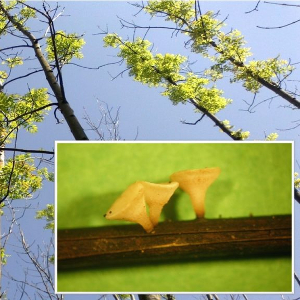 | Kádasi-Horáková, M; Adamčíková, K; Pastirčáková, K; Longauerová, V; Maľová, M Natural infection of Fraxinus angustifolia by Hymenoscyphus fraxineus in Slovakia Journal Article Baltic Forestry, 23 (1), pp. 52-55, 2017, ISSN: 2029-9230. @article{M.2017b, title = {Natural infection of \textit{Fraxinus angustifolia} by \textit{Hymenoscyphus fraxineus} in Slovakia}, author = {M. Kádasi-Horáková and K. Adamčíková and K. Pastirčáková and V. Longauerová and M. Maľová}, url = {https://www.balticforestry.mi.lt/bf/PDF_Articles/2017-23%5B1%5D/Baltic%20Forestry%202017.1_052-055.pdf}, issn = {2029-9230}, year = {2017}, date = {2017-04-07}, journal = {Baltic Forestry}, volume = {23}, number = {1}, pages = {52-55}, abstract = {The fungus Hymenoscyphus fraxineus is responsible for dieback of common ash (Fraxinus excelsior) and in some parts of Europe also of narrow-leaved ash (F. angustifolia). The first symptoms of ash dieback have been recorded on F. excelsior in Slovakia since 2004. This study reports about the first natural occurrence of H. fraxineus on F. angustifolia in Slovakia. The field investigation was carried out in 2014. The segments of diseased shoots and last year’s petioles were collected in clonal seed orchard situated in southwest part of the country. The fungus was isolated from infected host tissue and identified using molecular techniques (DNA extraction from pure cultures and apothecia, conventional PCR).}, keywords = {}, pubstate = {published}, tppubtype = {article} } The fungus Hymenoscyphus fraxineus is responsible for dieback of common ash (Fraxinus excelsior) and in some parts of Europe also of narrow-leaved ash (F. angustifolia). The first symptoms of ash dieback have been recorded on F. excelsior in Slovakia since 2004. This study reports about the first natural occurrence of H. fraxineus on F. angustifolia in Slovakia. The field investigation was carried out in 2014. The segments of diseased shoots and last year’s petioles were collected in clonal seed orchard situated in southwest part of the country. The fungus was isolated from infected host tissue and identified using molecular techniques (DNA extraction from pure cultures and apothecia, conventional PCR). |
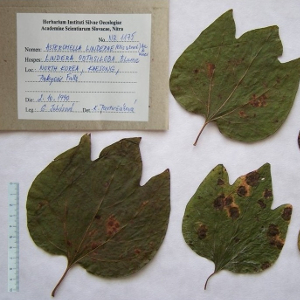 | Pastirčáková, K; Shin, H D Contribution to the pathogenic fungi on woody plants in North Korea Journal Article Phytotaxa, 299 (2), pp. 185-198, 2017, ISSN: 1179-3155. @article{K.2017, title = {Contribution to the pathogenic fungi on woody plants in North Korea}, author = {K. Pastirčáková and H.D. Shin}, url = {https://www.biotaxa.org/Phytotaxa/article/view/phytotaxa.299.2.3}, doi = {10.11646/phytotaxa.299.2.3}, issn = {1179-3155}, year = {2017}, date = {2017-03-21}, journal = {Phytotaxa}, volume = {299}, number = {2}, pages = {185-198}, abstract = {This paper presents the first checklist of pathogenic fungi on woody plants in North Korea. The checklist enumerates 146 species of fungi belonging to 79 genera, growing on 108 host plants belonging to 58 genera and 35 families. Two hosts and 57 fungal species represent first records in North Korea.}, keywords = {}, pubstate = {published}, tppubtype = {article} } This paper presents the first checklist of pathogenic fungi on woody plants in North Korea. The checklist enumerates 146 species of fungi belonging to 79 genera, growing on 108 host plants belonging to 58 genera and 35 families. Two hosts and 57 fungal species represent first records in North Korea. |
2016 |
|
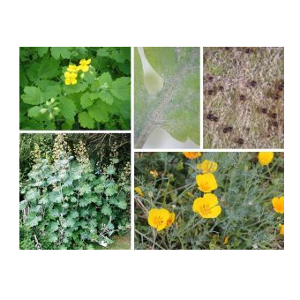 | Pastirčáková, K; Jankovics, T; Komáromi, J; Pintye, A; Pastirčák, M Genetic diversity and host range of powdery mildews on Papaveraceae Journal Article Mycological Progress, 15 (4, article 36), pp. 1-18, 2016, ISSN: 1617-416X. @article{K.2016, title = {Genetic diversity and host range of powdery mildews on Papaveraceae}, author = {K. Pastirčáková and T. Jankovics and J. Komáromi and A. Pintye and M. Pastirčák}, url = {https://link.springer.com/article/10.1007/s11557-016-1178-8}, doi = {10.1007/s11557-016-1178-8}, issn = {1617-416X}, year = {2016}, date = {2016-04-08}, journal = {Mycological Progress}, volume = {15}, number = {4, article 36}, pages = {1-18}, abstract = {Because of the strong morphological similarity of the powdery mildew fungi that infect papaveraceous hosts, a total of 39 samples were studied to reveal the phylogeny and host range of these fungi. ITS and 28S sequence analyses revealed that the isolates identified earlier as Erysiphe cruciferarum on papaveraceous hosts represent distinct lineages and differ from that of E. cruciferarum sensu stricto on brassicaceous hosts. The taxonomic status of the anamorph infecting Eschscholzia californica was revised, and therefore, a new species name, Erysiphe eschscholziae, is proposed. The taxonomic position of the Pseudoidium anamorphs infecting Glaucium flavum, Meconopsis cambrica, Papaver dubium, and Stylophorum diphyllum remain unclear. This study revealed that Erysiphe macleayae exhibits a specific host range different from that of E. cruciferarum, the common pathogen of papaveraceous hosts. Although E. macleayae occurred naturally on Macleaya cordata, Macleaya microcarpa, M. cambrica, and Chelidonium majus only, our inoculation tests revealed that the fungus was capable of infecting Argemone grandiflora, Glaucium corniculatum, Papaver rhoeas, and Papaver somniferum, indicating that these plant species may also be taken into account as potential hosts. Erysiphe cruciferarum originating from P. somniferum was not able to infect A. grandiflora, C. majus, E. californica, M. cordata, and P. rhoeas. The emergence of E. macleayae on M. microcarpa is reported here for the first time from the Czech Republic and Slovakia. The appearance of chasmothecia of E. macleayae on C. majus in Slovakia was reported, as well. Erysiphe cruciferarum was identified on G. corniculatum and reported here for the first time from Slovakia.}, keywords = {}, pubstate = {published}, tppubtype = {article} } Because of the strong morphological similarity of the powdery mildew fungi that infect papaveraceous hosts, a total of 39 samples were studied to reveal the phylogeny and host range of these fungi. ITS and 28S sequence analyses revealed that the isolates identified earlier as Erysiphe cruciferarum on papaveraceous hosts represent distinct lineages and differ from that of E. cruciferarum sensu stricto on brassicaceous hosts. The taxonomic status of the anamorph infecting Eschscholzia californica was revised, and therefore, a new species name, Erysiphe eschscholziae, is proposed. The taxonomic position of the Pseudoidium anamorphs infecting Glaucium flavum, Meconopsis cambrica, Papaver dubium, and Stylophorum diphyllum remain unclear. This study revealed that Erysiphe macleayae exhibits a specific host range different from that of E. cruciferarum, the common pathogen of papaveraceous hosts. Although E. macleayae occurred naturally on Macleaya cordata, Macleaya microcarpa, M. cambrica, and Chelidonium majus only, our inoculation tests revealed that the fungus was capable of infecting Argemone grandiflora, Glaucium corniculatum, Papaver rhoeas, and Papaver somniferum, indicating that these plant species may also be taken into account as potential hosts. Erysiphe cruciferarum originating from P. somniferum was not able to infect A. grandiflora, C. majus, E. californica, M. cordata, and P. rhoeas. The emergence of E. macleayae on M. microcarpa is reported here for the first time from the Czech Republic and Slovakia. The appearance of chasmothecia of E. macleayae on C. majus in Slovakia was reported, as well. Erysiphe cruciferarum was identified on G. corniculatum and reported here for the first time from Slovakia. |
2014 |
|
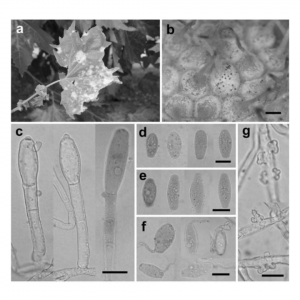 | Pastirčáková, K; Pastirčák, M; Adamčiková, K; Bouznad, Z; Kedad, A; El_Guilli, M; Diminić, D; Hofte, M Global distribution of Erysiphe platani: new records, teleomorph formation and re-examination of herbarium collections Journal Article Cryptogamie, Mycologie, 35 (2), pp. 163-176, 2014, ISSN: 0181-1584. @article{K.2014, title = {Global distribution of \textit{Erysiphe platani}: new records, teleomorph formation and re-examination of herbarium collections}, author = {K. Pastirčáková and M. Pastirčák and K. Adamčiková and Z. Bouznad and A. Kedad and M. El_Guilli and D. Diminić and M. Hofte}, url = {http://www.bioone.org/doi/abs/10.7872/crym.v35.iss2.2014.163?journalCode=crym}, doi = {10.7872/crym.v35.iss2.2014.163}, issn = {0181-1584}, year = {2014}, date = {2014-06-01}, journal = {Cryptogamie, Mycologie}, volume = {35}, number = {2}, pages = {163-176}, abstract = {A global survey of the spread of the Platanus powdery mildew, Erysiphe platani, has been carried out. E. platani teleomorph formation was recorded in countries where the fungus anamorph has been present for several years. The first findings of chasmothecia were recorded in Austria, Czech Republic, France, Italy and Slovakia. New records of E. platani (including the teleomorph) were found in Belgium, Croatia and Denmark. The occurrence of this fungus in Sweden and in two countries of North Africa (Algeria and Morocco) was confirmed. Descriptions of morphological features, illustrations, and worldwide distribution of E. platani are provided. Herbarium collections of powdery mildews on Platanus spp. were re-examined and revised. The occurrence of Phyllactinia guttata on Platanus is discussed and questioned.}, keywords = {}, pubstate = {published}, tppubtype = {article} } A global survey of the spread of the Platanus powdery mildew, Erysiphe platani, has been carried out. E. platani teleomorph formation was recorded in countries where the fungus anamorph has been present for several years. The first findings of chasmothecia were recorded in Austria, Czech Republic, France, Italy and Slovakia. New records of E. platani (including the teleomorph) were found in Belgium, Croatia and Denmark. The occurrence of this fungus in Sweden and in two countries of North Africa (Algeria and Morocco) was confirmed. Descriptions of morphological features, illustrations, and worldwide distribution of E. platani are provided. Herbarium collections of powdery mildews on Platanus spp. were re-examined and revised. The occurrence of Phyllactinia guttata on Platanus is discussed and questioned. |
 | Ondrušková, E; Juhásová, G; Pastirčáková, K The lily magnolia powdery mildew Erysiphe magnifica found in Slovakia Journal Article Mycotaxon, 127 , pp. 51-57, 2014, ISSN: 0093-4666. @article{E.2014, title = {The lily magnolia powdery mildew \textit{Erysiphe magnifica} found in Slovakia}, author = {E. Ondrušková and G. Juhásová and K. Pastirčáková}, url = {http://www.ingentaconnect.com/contentone/mtax/mt/2014/00000127/00000001/art00010}, doi = {10.5248/127.51}, issn = {0093-4666}, year = {2014}, date = {2014-03-01}, journal = {Mycotaxon}, volume = {127}, pages = {51-57}, abstract = {Powdery mildew symptoms were observed on leaves of lily magnolia (Magnolia liliiflora) in Slovakia. The causal fungus was identified as Erysiphe magnifica based on the morphology of both anamorphic and teleomorphic stages. This is the first report of E. magnifica on lily magnolia in Slovakia. A detailed description, illustrations, the host range, and the distribution of this fungus are given.}, keywords = {}, pubstate = {published}, tppubtype = {article} } Powdery mildew symptoms were observed on leaves of lily magnolia (Magnolia liliiflora) in Slovakia. The causal fungus was identified as Erysiphe magnifica based on the morphology of both anamorphic and teleomorphic stages. This is the first report of E. magnifica on lily magnolia in Slovakia. A detailed description, illustrations, the host range, and the distribution of this fungus are given. |
2013 |
|
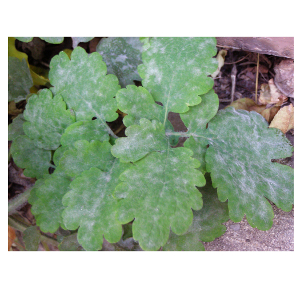 | Pastirčáková, K; Pastirčák, M A powdery mildew (Pseudoidium sp.) found on Chelidonium majus in the Czech Republic and Slovakia Journal Article Czech Mycology, 65 (1), pp. 125-133, 2013, ISSN: 1211-0981. @article{K.2013b, title = {A powdery mildew (\textit{Pseudoidium} sp.) found on \textit{Chelidonium majus} in the Czech Republic and Slovakia}, author = {K. Pastirčáková and M. Pastirčák}, url = {http://www.czechmycology.org/_cmo/CM65110.pdf}, issn = {1211-0981}, year = {2013}, date = {2013-06-10}, journal = {Czech Mycology}, volume = {65}, number = {1}, pages = {125-133}, abstract = {The find of a powdery mildew (Pseudoidium sp.) on Chelidonium majus in the Czech Republic and Slovakia is reported. Disease symptoms and morphological characteristics of the anamorph are described. No teleomorph was observed. Morphology and distribution of other powdery mildew species on hosts of the Papaveraceae are discussed. We point out the need for phylogenetic analysis of three closely related species (Erysiphe cruciferarum, E. hylomeci, and E. macleayae) and determination of its relationship to the fungus on C. majus.}, keywords = {}, pubstate = {published}, tppubtype = {article} } The find of a powdery mildew (Pseudoidium sp.) on Chelidonium majus in the Czech Republic and Slovakia is reported. Disease symptoms and morphological characteristics of the anamorph are described. No teleomorph was observed. Morphology and distribution of other powdery mildew species on hosts of the Papaveraceae are discussed. We point out the need for phylogenetic analysis of three closely related species (Erysiphe cruciferarum, E. hylomeci, and E. macleayae) and determination of its relationship to the fungus on C. majus. |
2010 |
|
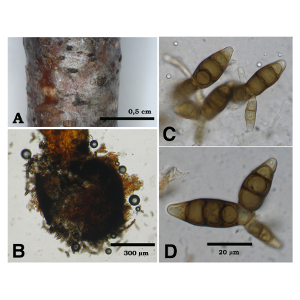 | Pastirčáková, K; Pastirčák, M Two important ascomycetes and their anamorphs on twigs of Betula pendula in Slovakia Journal Article Polish Botanical Journal, 55 (2), pp. 373-380, 2010, ISSN: 1641-8180. @article{Pastirčáková2010, title = {Two important ascomycetes and their anamorphs on twigs of \emph{Betula pendula} in Slovakia}, author = {K. Pastirčáková and M. Pastirčák}, issn = {1641-8180}, year = {2010}, date = {2010-01-01}, journal = {Polish Botanical Journal}, volume = {55}, number = {2}, pages = {373-380}, abstract = {The paper reports two fungal species of Pleomassariaceae new for the Slovak mycobiota: Pleomassaria siparia (Berk. & Broome) Sacc. and Splanchnonema argus (Berk. & Broome) Kuntze, found on dead twigs of Betula pendula Roth. The morphology of the fungi and their coelomycetous anamorphs is described, with photographic documentation.}, keywords = {}, pubstate = {published}, tppubtype = {article} } The paper reports two fungal species of Pleomassariaceae new for the Slovak mycobiota: Pleomassaria siparia (Berk. & Broome) Sacc. and Splanchnonema argus (Berk. & Broome) Kuntze, found on dead twigs of Betula pendula Roth. The morphology of the fungi and their coelomycetous anamorphs is described, with photographic documentation. |
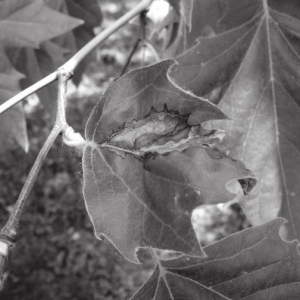 | Ivanová, H; Bernardovičová, S; Pastirčáková, K Influence of selected climatological characteristics on antracnose diseases development on plane trees Journal Article Ekológia (Bratislava), 29 (4), pp. 430-440, 2010. @article{Ivanová2010, title = {Influence of selected climatological characteristics on antracnose diseases development on plane trees}, author = {H. Ivanová and S. Bernardovičová and K. Pastirčáková}, year = {2010}, date = {2010-01-01}, journal = {Ekológia (Bratislava)}, volume = {29}, number = {4}, pages = {430-440}, keywords = {}, pubstate = {published}, tppubtype = {article} } |
2009 |
|
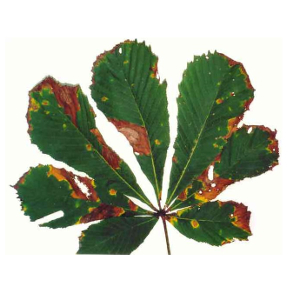 | Pastirčáková, K; Pastirčák, M; Celar, F; Shin, H D Guignardia aesculi on species of Aesculus: new records from Europe and Asia Journal Article Mycotaxon, 108 , pp. 287-296, 2009, ISSN: 0093-4666. @article{Pastirčáková2009, title = {\textit{Guignardia aesculi} on species of \textit{Aesculus}: new records from Europe and Asia}, author = {K. Pastirčáková and M. Pastirčák and F. Celar and H.D. Shin}, issn = {0093-4666}, year = {2009}, date = {2009-01-01}, journal = {Mycotaxon}, volume = {108}, pages = {287-296}, abstract = {New localities of Guignardia aesculi on leaves of seven Aesculus species (×carnea, flava, hippocastanum, ×neglecta, parviflora, pavia, turbinata) were recorded in Europe. The teleomorph was found on overwintered leaves of A. hippocastanum in Slovakia. The occurrence of the Guignardia leaf blotch on A. hippocastanum and A. turbinata was also confirmed for the first time in South Korea. The causal fungus Guignardia aesculi and its conidial anamorph Phyllosticta sphaeropsoidea and spermatial synanamorph Leptodothiorella aesculicola are described in detail and illustrated. Pathogenicity of the fungus was confirmed by inoculating horse chestnut leaves with conidia.}, keywords = {}, pubstate = {published}, tppubtype = {article} } New localities of Guignardia aesculi on leaves of seven Aesculus species (×carnea, flava, hippocastanum, ×neglecta, parviflora, pavia, turbinata) were recorded in Europe. The teleomorph was found on overwintered leaves of A. hippocastanum in Slovakia. The occurrence of the Guignardia leaf blotch on A. hippocastanum and A. turbinata was also confirmed for the first time in South Korea. The causal fungus Guignardia aesculi and its conidial anamorph Phyllosticta sphaeropsoidea and spermatial synanamorph Leptodothiorella aesculicola are described in detail and illustrated. Pathogenicity of the fungus was confirmed by inoculating horse chestnut leaves with conidia. |
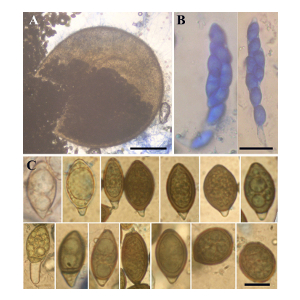 | Pastirčák, M; Pastirčáková, K European record of Subramaniula thielavioides on opium poppy Journal Article Acta Mycologica, 44 (1), pp. 7-9, 2009, ISSN: 0001-625X. @article{Pastirčák2009, title = {European record of \textit{Subramaniula thielavioides} on opium poppy}, author = {M. Pastirčák and K. Pastirčáková}, issn = {0001-625X}, year = {2009}, date = {2009-01-01}, journal = {Acta Mycologica}, volume = {44}, number = {1}, pages = {7-9}, abstract = {In the course of a study of fungal biodiversity of opium poppy (Papaver somniferum) plants collected in production area of Slovakia, an ascomycete belonging to the genus Subramaniula was isolated. The fungus identified as Subramaniula thielavioides has been reported for the first time from Slovakia. This record also represents the first European locality. Brief morphological description of the fungus based on an isolate from flower petals of opium poppy is provided.}, keywords = {}, pubstate = {published}, tppubtype = {article} } In the course of a study of fungal biodiversity of opium poppy (Papaver somniferum) plants collected in production area of Slovakia, an ascomycete belonging to the genus Subramaniula was isolated. The fungus identified as Subramaniula thielavioides has been reported for the first time from Slovakia. This record also represents the first European locality. Brief morphological description of the fungus based on an isolate from flower petals of opium poppy is provided. |
2008 |
|
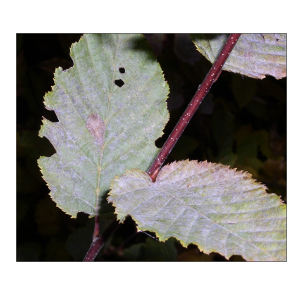 | Pastirčáková, K; Takamatsu, S; Shiroya, Y; Pastirčák, M European hornbeam powdery mildew Erysiphe arcuata in Slovakia Journal Article Journal of Phytopathology, 156 (10), pp. 597-601, 2008, ISSN: 0931-1785. @article{pastirčákovápastirčáková2008, title = {European hornbeam powdery mildew \textit{Erysiphe arcuata} in Slovakia}, author = {K. Pastirčáková and S. Takamatsu and Y. Shiroya and M. Pastirčák}, doi = {10.1111/j.1439-0434.2008.01408.x}, issn = {0931-1785}, year = {2008}, date = {2008-01-01}, journal = {Journal of Phytopathology}, volume = {156}, number = {10}, pages = {597-601}, abstract = {Erysiphe arcuata found on European hornbeam (Carpinus betulus) is reported from Slovakia for the first time. Taxonomic characters of the anamorphic and teleomorphic states of E. arcuata were described and illustrated. Additionally, disease symptoms caused by this pathogen were presented. The identification of the fungus is based on morphological data combined with the results of a sequence analysis.}, keywords = {}, pubstate = {published}, tppubtype = {article} } Erysiphe arcuata found on European hornbeam (Carpinus betulus) is reported from Slovakia for the first time. Taxonomic characters of the anamorphic and teleomorphic states of E. arcuata were described and illustrated. Additionally, disease symptoms caused by this pathogen were presented. The identification of the fungus is based on morphological data combined with the results of a sequence analysis. |
 | Pastirčáková, K; Ivanová, H; Bernadovičová, S Neoerysiphe galeopsidis on Stachys species in Slovakia and the Czech Republic based on a re-examination of herbarium collections. Journal Article Czech Mycology, 60 (2), pp. 251-264, 2008, ISSN: 1211-0981. @article{Pastirčáková2008b, title = {\textit{Neoerysiphe galeopsidis} on \textit{Stachys} species in Slovakia and the Czech Republic based on a re-examination of herbarium collections.}, author = {K. Pastirčáková and H. Ivanová and S. Bernadovičová}, issn = {1211-0981}, year = {2008}, date = {2008-01-01}, journal = {Czech Mycology}, volume = {60}, number = {2}, pages = {251-264}, abstract = {On the basis of re-examinations of herbarium collections, species of the genus Stachys as host plants of the powdery mildew species Neoerysiphe galeopsidis in Slovakia and the Czech Republic were verified. A detailed description, illustrations, the host range and the distribution of this fungus are given.}, keywords = {}, pubstate = {published}, tppubtype = {article} } On the basis of re-examinations of herbarium collections, species of the genus Stachys as host plants of the powdery mildew species Neoerysiphe galeopsidis in Slovakia and the Czech Republic were verified. A detailed description, illustrations, the host range and the distribution of this fungus are given. |
2007 |
|
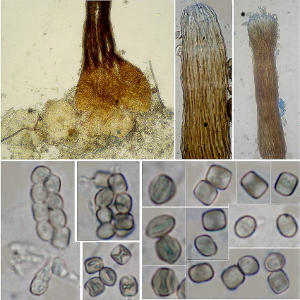 | Pastirčák, M; Pastirčáková, K Scopinella solani on graminicolous hosts in Slovakia and the Czech Republic Journal Article Mycotaxon, 102 , pp. 383-387, 2007, ISSN: 0093-4666. @article{Pastirčák2007, title = {\textit{Scopinella solani} on graminicolous hosts in Slovakia and the Czech Republic}, author = {M. Pastirčák and K. Pastirčáková}, issn = {0093-4666}, year = {2007}, date = {2007-01-01}, journal = {Mycotaxon}, volume = {102}, pages = {383-387}, abstract = {Scopinella solani was found on overwintered inflorescences of Brachypodium pinnatum, Dactylis glomerata, and Elytrigia repens. The morphological characteristics and host range of S. solani are described. These are the first records of S. solani in Slovakia and the Czech Republic.}, keywords = {}, pubstate = {published}, tppubtype = {article} } Scopinella solani was found on overwintered inflorescences of Brachypodium pinnatum, Dactylis glomerata, and Elytrigia repens. The morphological characteristics and host range of S. solani are described. These are the first records of S. solani in Slovakia and the Czech Republic. |
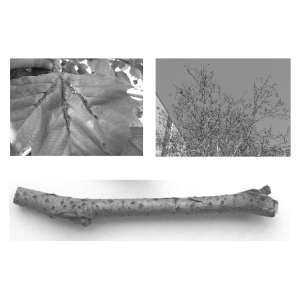 | Ivanova, H; Bernardovičová, S; Pastirčáková, K Influence of changed ecological conditions of environment on occurrence of London plane (Platanus x hispanica Münchh.) anthracnose Journal Article Folia Oecologica, 34 (1), pp. 1-8, 2007, ISBN: 1336-5266. @article{Ivanova2007, title = {Influence of changed ecological conditions of environment on occurrence of London plane (Platanus x hispanica Münchh.) anthracnose}, author = {H. Ivanova and S. Bernardovičová and K. Pastirčáková}, url = {http://ife.sk/wp-content/uploads/2016/10/FO_34_1_Pastircakova.pdf}, isbn = {1336-5266}, year = {2007}, date = {2007-01-01}, journal = {Folia Oecologica}, volume = {34}, number = {1}, pages = {1-8}, abstract = {During 2004–2007, reappearances of anthracnose on Platanus × hispanica caused by the microscopical fungus Apiognomonia veneta were recorded. Causal agent of the disease was isolated from symptomatic leaves and twigs, with characteristic spots and lesions, sampled from affected host trees growing in urban environment at the selected locality (Nitra). Subsequent identification and morphological description of fungal isolates was made by microscopical differentiation, according to the fungi identification key. Our study has confirmed interannual changes in the disease severity and influence of temperature in period decisive for occurrence and progress of the disease. Cool springs are more promoting severe plane anthrac-nose outbreaks. Repeated annual removal of twigs and leaves results in weakening of plane trees.}, keywords = {}, pubstate = {published}, tppubtype = {article} } During 2004–2007, reappearances of anthracnose on Platanus × hispanica caused by the microscopical fungus Apiognomonia veneta were recorded. Causal agent of the disease was isolated from symptomatic leaves and twigs, with characteristic spots and lesions, sampled from affected host trees growing in urban environment at the selected locality (Nitra). Subsequent identification and morphological description of fungal isolates was made by microscopical differentiation, according to the fungi identification key. Our study has confirmed interannual changes in the disease severity and influence of temperature in period decisive for occurrence and progress of the disease. Cool springs are more promoting severe plane anthrac-nose outbreaks. Repeated annual removal of twigs and leaves results in weakening of plane trees. |
2006 |
|
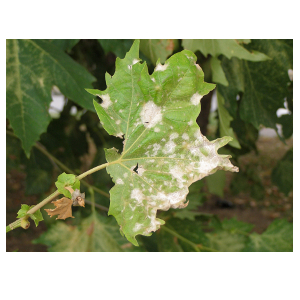 | Pastirčáková, K; Pastirčák, M The anamorph of Erysiphe platani on Platanus ×hispanica in Slovakia Journal Article Mycotaxon, 97 , pp. 189-194, 2006, ISSN: 0093-4666. @article{Pastirčáková2006, title = {The anamorph of \textit{Erysiphe platani} on \textit{Platanus ×hispanica} in Slovakia}, author = {K. Pastirčáková and M. Pastirčák}, issn = {0093-4666}, year = {2006}, date = {2006-01-01}, journal = {Mycotaxon}, volume = {97}, pages = {189-194}, abstract = {A species of powdery mildew new for the Slovak mycoflora, Erysiphe platani, which parasitizes on plane trees, is reported. Disease symptoms and morphological characteristics of the anamorph are described. No teleomorph was observed. }, keywords = {}, pubstate = {published}, tppubtype = {article} } A species of powdery mildew new for the Slovak mycoflora, Erysiphe platani, which parasitizes on plane trees, is reported. Disease symptoms and morphological characteristics of the anamorph are described. No teleomorph was observed. |
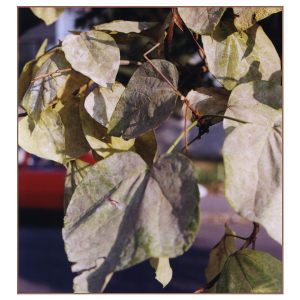 | Pastirčáková, K; Pastirčák, M; Juhásová, G The Catalpa powdery mildew Erysiphe elevata in Slovakia Journal Article Cryptogamie, Mycologie, 27 (1), pp. 31-34, 2006, ISSN: 0181-1584. @article{Pastirčáková2006b, title = {The Catalpa powdery mildew \textit{Erysiphe elevata} in Slovakia}, author = {K. Pastirčáková and M. Pastirčák and G. Juhásová}, issn = {0181-1584}, year = {2006}, date = {2006-01-01}, journal = {Cryptogamie, Mycologie}, volume = {27}, number = {1}, pages = {31-34}, abstract = {The first record of Erysiphe elevata (Burrill) U. Braun & S. Takamatsu (syn. Microsphaera elevata Burrill), North American powdery mildew in Slovakia is presented. It was found on living leaves and fruits of southem catalpa (Catalpa bignonioides Walt.). The fungus is described and photographically documented.}, keywords = {}, pubstate = {published}, tppubtype = {article} } The first record of Erysiphe elevata (Burrill) U. Braun & S. Takamatsu (syn. Microsphaera elevata Burrill), North American powdery mildew in Slovakia is presented. It was found on living leaves and fruits of southem catalpa (Catalpa bignonioides Walt.). The fungus is described and photographically documented. |
2004 |
|
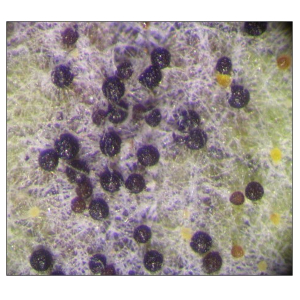 | Ale-Agha, N; Bolay, A; Braun, U; Feige, B; Jage, H; Kummer, V; Lebeda, A; Piątek, M; Shin, H D; Zimmermannová-Pastirčáková, K Erysiphe catalpae and Erysiphe elevata in Europe Journal Article Mycological Progress, 3 (4), pp. 291-296, 2004, ISSN: 1617-416X. @article{Ale-Agha2004, title = {\textit{Erysiphe catalpae} and \textit{Erysiphe elevata} in Europe}, author = {N. Ale-Agha and A. Bolay and U. Braun and B. Feige and H. Jage and V. Kummer and A. Lebeda and M. Piątek and H.D. Shin and K. Zimmermannová-Pastirčáková}, issn = {1617-416X}, year = {2004}, date = {2004-01-01}, journal = {Mycological Progress}, volume = {3}, number = {4}, pages = {291-296}, abstract = {The recent epidemic spread of the North American powdery mildew Erysiphe elevata in Europe is described and discussed. Since 2002, this plant pathogenic fungus has been collected on Catalpa bignonioides, C. erubescens and C. speciosa in the Czech Republic, Germany, Hungary, Slovakia and Switzerland. The diagnostically important anamorph of E. elevata, so far unknown, is described and illustrated in detail. Type material of Erysiphe catalpae and two specimens of E. catalpae recently collected in Poland have been examined and compared with E. elevata. The anamorph as well as the teleomorph of E. catalpae proved to be easily distinguishable from E. elevata. The supposition that E. catalpae, introduced in Armenia, was based on immature ascomata of E. elevata proved to be wrong. The origin and distribution of E. catalpae are discussed, and a key to powdery mildew fungi on Catalpa spp. in Europe is provided.}, keywords = {}, pubstate = {published}, tppubtype = {article} } The recent epidemic spread of the North American powdery mildew Erysiphe elevata in Europe is described and discussed. Since 2002, this plant pathogenic fungus has been collected on Catalpa bignonioides, C. erubescens and C. speciosa in the Czech Republic, Germany, Hungary, Slovakia and Switzerland. The diagnostically important anamorph of E. elevata, so far unknown, is described and illustrated in detail. Type material of Erysiphe catalpae and two specimens of E. catalpae recently collected in Poland have been examined and compared with E. elevata. The anamorph as well as the teleomorph of E. catalpae proved to be easily distinguishable from E. elevata. The supposition that E. catalpae, introduced in Armenia, was based on immature ascomata of E. elevata proved to be wrong. The origin and distribution of E. catalpae are discussed, and a key to powdery mildew fungi on Catalpa spp. in Europe is provided. |
2002 |
|
 | Zimmermannová-Pastirčáková, K; Pastirčák, M Erysiphe flexuosa – a new species of powdery mildew for Slovakia Journal Article Biologia (Bratislava), 57 (4), pp. 437-440, 2002, ISSN: 0006-3088. @article{Zimmermanová-Pastirčáková2002, title = {\textit{Erysiphe flexuosa} – a new species of powdery mildew for Slovakia}, author = {K. Zimmermannová-Pastirčáková and M. Pastirčák}, issn = {0006-3088}, year = {2002}, date = {2002-01-01}, journal = {Biologia (Bratislava)}, volume = {57}, number = {4}, pages = {437-440}, abstract = {Erysiphe flexuosa (Peck) U. Braun & S. Takamatsu, a new powdery mildew for Slovakia is presented. It was found on living leaves of common horse chestnut (Aesculus hippocastanum L.) and red horse chestnut (Aesculus x camea Hayne). We recorded massive occurrence or this fungus also in Austria. The fungus is described and photographically documented.}, keywords = {}, pubstate = {published}, tppubtype = {article} } Erysiphe flexuosa (Peck) U. Braun & S. Takamatsu, a new powdery mildew for Slovakia is presented. It was found on living leaves of common horse chestnut (Aesculus hippocastanum L.) and red horse chestnut (Aesculus x camea Hayne). We recorded massive occurrence or this fungus also in Austria. The fungus is described and photographically documented. |
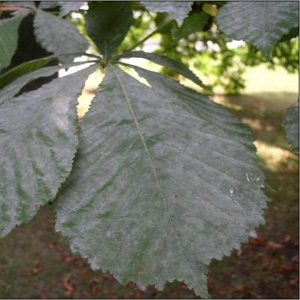 | Zimmermannová-Pastirčáková, K; Adamska, I; Błaszkowski, J; Bolay, A; Braun, U Epidemic spread of Erysiphe flexuosa (North American powdery mildew disease of horse-chestnut) in Europe Journal Article Schlechtendalia, 8 , pp. 39-45, 2002, ISSN: 1436-2317. @article{Zimmermannová-Pastirčáková2002, title = {Epidemic spread of \textit{Erysiphe flexuosa} (North American powdery mildew disease of horse-chestnut) in Europe}, author = {K. Zimmermannová-Pastirčáková and I. Adamska and J. Błaszkowski and A. Bolay and U. Braun}, issn = {1436-2317}, year = {2002}, date = {2002-01-01}, journal = {Schlechtendalia}, volume = {8}, pages = {39-45}, abstract = {The European epidemic spread of Erysiphe (Uncinula) flexuosa, the North American horse-chestnut powdery mildew fungus, is discussed. New collections of this plant disease from Austria, Croatia, Czech Republik, France, Poland, Slovakia and Switzerland on leaves and occasionally stems of Aesculus × carnea, A. chinensis, A. hippocastanum, A. indica, A. neglecta and A. × plantierensis from 2000 and 2001 are reported. The taxonomy of this fungus is discussed and disease symptoms and microscopic features, including some new observations, are described and illustrated.}, keywords = {}, pubstate = {published}, tppubtype = {article} } The European epidemic spread of Erysiphe (Uncinula) flexuosa, the North American horse-chestnut powdery mildew fungus, is discussed. New collections of this plant disease from Austria, Croatia, Czech Republik, France, Poland, Slovakia and Switzerland on leaves and occasionally stems of Aesculus × carnea, A. chinensis, A. hippocastanum, A. indica, A. neglecta and A. × plantierensis from 2000 and 2001 are reported. The taxonomy of this fungus is discussed and disease symptoms and microscopic features, including some new observations, are described and illustrated. |
2001 |
|
 | Zimmermannová, K; Svoboda, L; Kalač, P Mercury, cadmium, lead and copper contents in fruiting bodies of selected edible mushrooms in contaminated Middle Spiš region, Slovakia Journal Article Ekológia (Bratislava), 20 (4), pp. 440-446, 2001, ISSN: 1335-342X. @article{Zimmermannová2001, title = {Mercury, cadmium, lead and copper contents in fruiting bodies of selected edible mushrooms in contaminated Middle Spiš region, Slovakia}, author = {K. Zimmermannová and L. Svoboda and P. Kalač}, issn = {1335-342X}, year = {2001}, date = {2001-01-01}, journal = {Ekológia (Bratislava)}, volume = {20}, number = {4}, pages = {440-446}, abstract = {Samples of fruiting bodies of wild growing edible mushrooms were collected in an immission area of a mercury smelter and a copper smelter in the region of the Middle Spiš in north-eastern Slovakia during periods 1990-1993 and 1997-1999. Totally 250 samples of 30 species were analysed by methods of atomic absorption spectrophotometry. There was found a considerable variability in the contents of the majority of observed trace elements both between the mushroom species and within individual species. Slovak food statutory limits were surpassed in 93.3, 82.0, 15.3 and 9.8 % for mercury, cadmium, lead and copper, respectively. The highest mean contents (mg.kg-' dry matter) of mercury were observed in Lepista nuda (70.1), Agaricus arvensis (64.8) and Hysterangium crassum (65.1). The highest mean values of cadmium were found in Boletus edulis (10.3), Xerocomus chrysenteron (10.0) and Lycoperdon perlatum (9.7) and that of lead in Lycoperdon perlatum (110.3). The highest mean level of copper was found in Hysterangium crassum (394.5). Contents of heavy metals in caps of fruiting bodies were higher than those in stipes of five selected species.}, keywords = {}, pubstate = {published}, tppubtype = {article} } Samples of fruiting bodies of wild growing edible mushrooms were collected in an immission area of a mercury smelter and a copper smelter in the region of the Middle Spiš in north-eastern Slovakia during periods 1990-1993 and 1997-1999. Totally 250 samples of 30 species were analysed by methods of atomic absorption spectrophotometry. There was found a considerable variability in the contents of the majority of observed trace elements both between the mushroom species and within individual species. Slovak food statutory limits were surpassed in 93.3, 82.0, 15.3 and 9.8 % for mercury, cadmium, lead and copper, respectively. The highest mean contents (mg.kg-' dry matter) of mercury were observed in Lepista nuda (70.1), Agaricus arvensis (64.8) and Hysterangium crassum (65.1). The highest mean values of cadmium were found in Boletus edulis (10.3), Xerocomus chrysenteron (10.0) and Lycoperdon perlatum (9.7) and that of lead in Lycoperdon perlatum (110.3). The highest mean level of copper was found in Hysterangium crassum (394.5). Contents of heavy metals in caps of fruiting bodies were higher than those in stipes of five selected species. |
2000 |
|
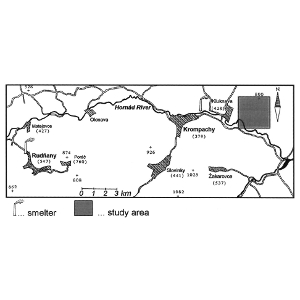 | Svoboda, L; Zimmermannová, K; Kalač, P Concentrations of mercury, cadmium, lead and copper in fruiting bodies of edible mushrooms in an emission area of a copper smelter and a mercury smelter Journal Article Science of the Total Environment, 246 , pp. 61-67, 2000, ISSN: 0048-9697. @article{Svoboda2000, title = {Concentrations of mercury, cadmium, lead and copper in fruiting bodies of edible mushrooms in an emission area of a copper smelter and a mercury smelter}, author = {L. Svoboda and K. Zimmermannová and P. Kalač}, issn = {0048-9697}, year = {2000}, date = {2000-01-01}, journal = {Science of the Total Environment}, volume = {246}, pages = {61-67}, abstract = {Four metals were determined by AAS techniques in 56 samples of 23 wild mushroom species collected in a heavily polluted area in eastern Slovakia in 1997 and 1998. The area has been contaminated from historical polymetallic ores mining and smelting and by emissions from a mercury smelter between 1969 and 1993 and from a copper smelter since 1951. No significant differences in metal concentrations (P˂0.05) were found in four species when comparing the periods 1992-1993 and 1997-1998. Considerable contamination of most species was observed mainly for mercury and cadmium. The highest levels of mercury, up to 50 mg/kg dry matter, were found in Boletus reticulatus, Lycoperdon perlatum and Marasmius oreades, and of cadmium up to 20 mg/kg dry matter in Xerocomus chrysenteron and Lycoperdon perlatum. The latter species also had extremely high lead and copper concentrations in hundreds of milligrams per kilogram dry matter. Concentrations of mercury and copper in caps of four Boletaceae species were significantly (P˂0.05) higher than those in stipes.}, keywords = {}, pubstate = {published}, tppubtype = {article} } Four metals were determined by AAS techniques in 56 samples of 23 wild mushroom species collected in a heavily polluted area in eastern Slovakia in 1997 and 1998. The area has been contaminated from historical polymetallic ores mining and smelting and by emissions from a mercury smelter between 1969 and 1993 and from a copper smelter since 1951. No significant differences in metal concentrations (P˂0.05) were found in four species when comparing the periods 1992-1993 and 1997-1998. Considerable contamination of most species was observed mainly for mercury and cadmium. The highest levels of mercury, up to 50 mg/kg dry matter, were found in Boletus reticulatus, Lycoperdon perlatum and Marasmius oreades, and of cadmium up to 20 mg/kg dry matter in Xerocomus chrysenteron and Lycoperdon perlatum. The latter species also had extremely high lead and copper concentrations in hundreds of milligrams per kilogram dry matter. Concentrations of mercury and copper in caps of four Boletaceae species were significantly (P˂0.05) higher than those in stipes. |
